Strategic Planning for Market Development in Iceland Supermarket
VerifiedAdded on 2020/01/07
|29
|4995
|258
Report
AI Summary
The assignment discusses the importance of strategic planning for Iceland supermarket, a company that aims to develop its market presence through effective marketing strategies. The report highlights the need for clear goals and targets, which should be SMART (Specific, Measurable, Achievable, Relevant, and Time-bound). It also emphasizes the significance of internal and external stakeholders, environmental factors, and resource availability in achieving the company's objectives. The report concludes that market development strategy is a suitable approach for Iceland supermarket, requiring various resources and timely implementation to achieve success.
Contribute Materials
Your contribution can guide someone’s learning journey. Share your
documents today.
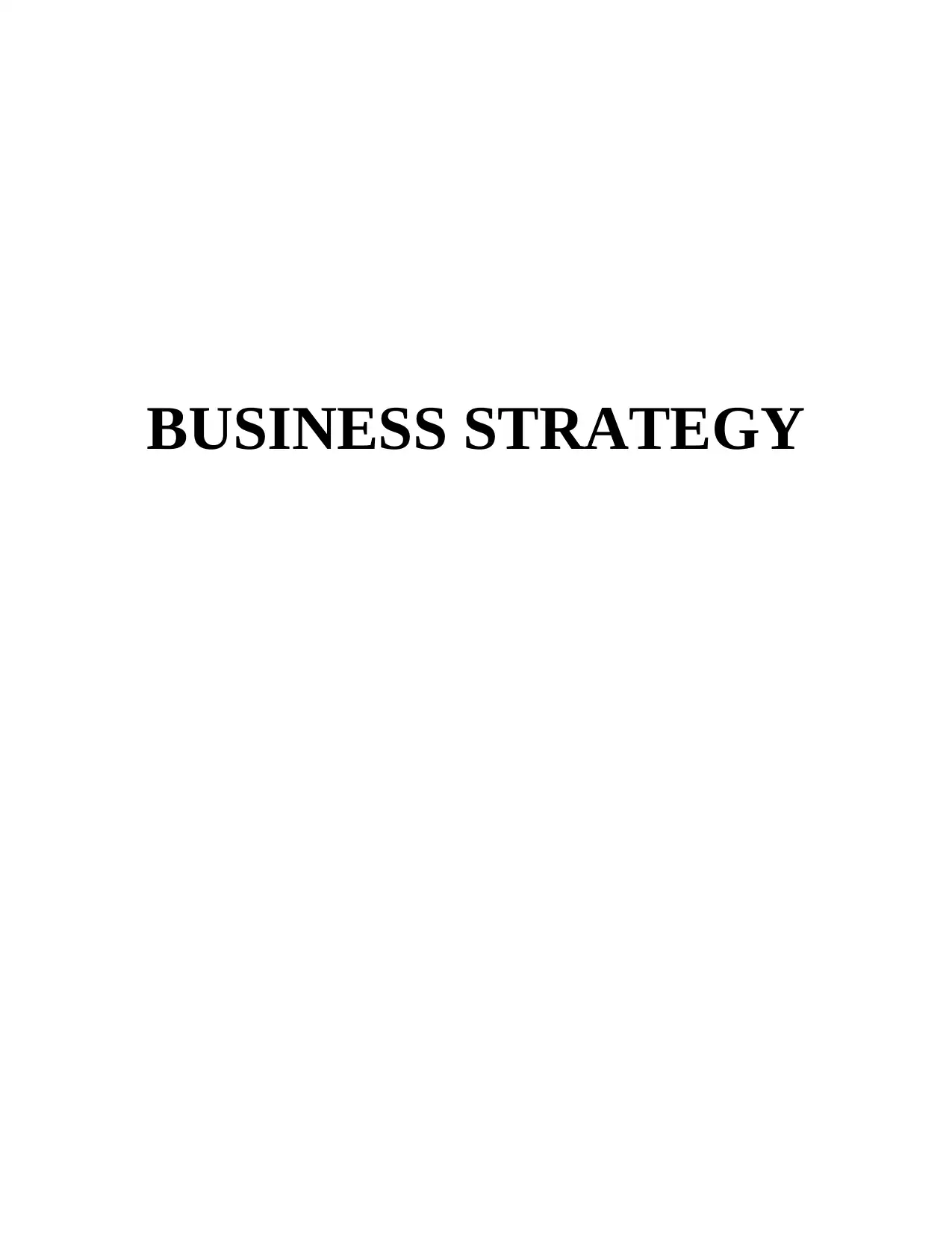
BUSINESS STRATEGY
Secure Best Marks with AI Grader
Need help grading? Try our AI Grader for instant feedback on your assignments.
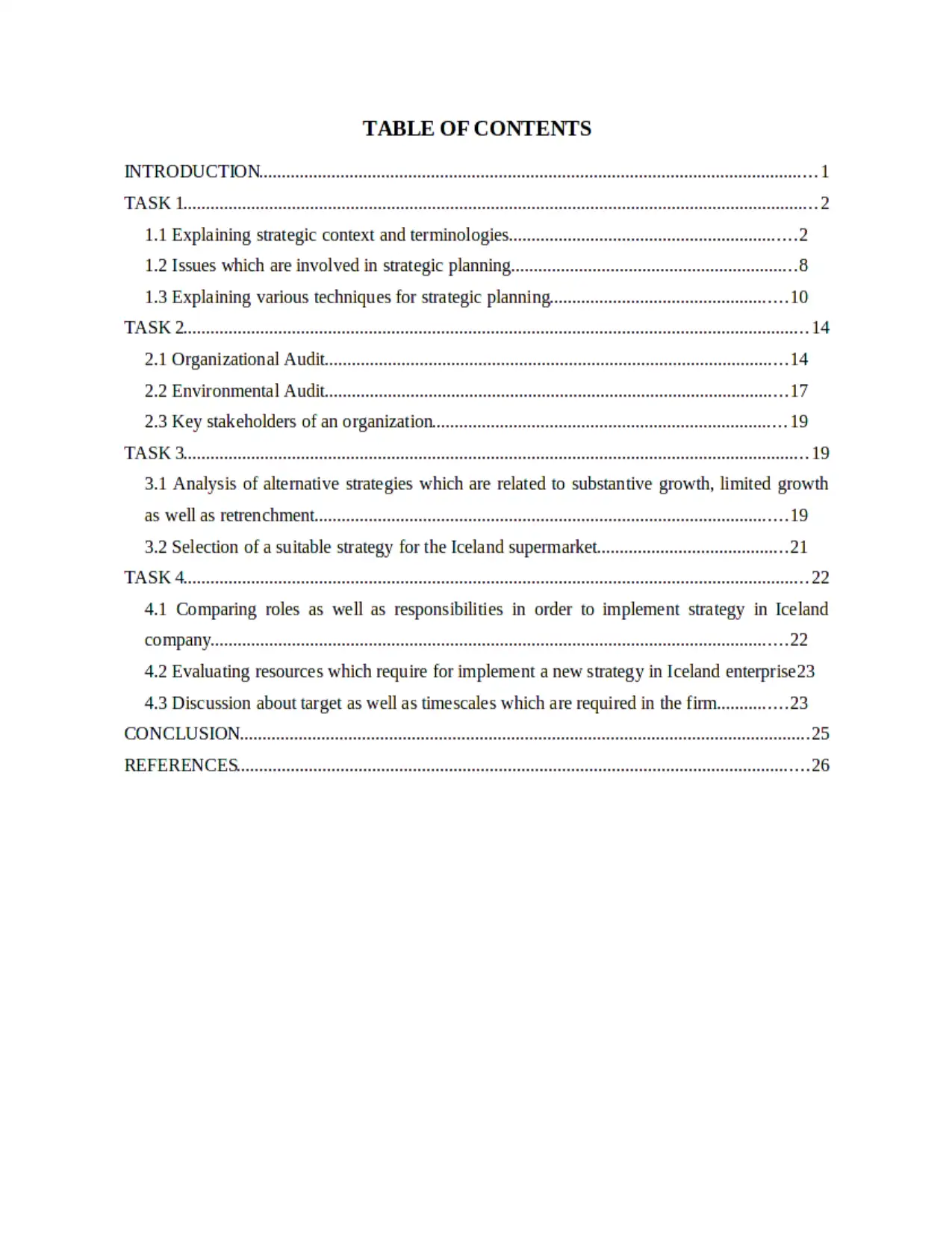
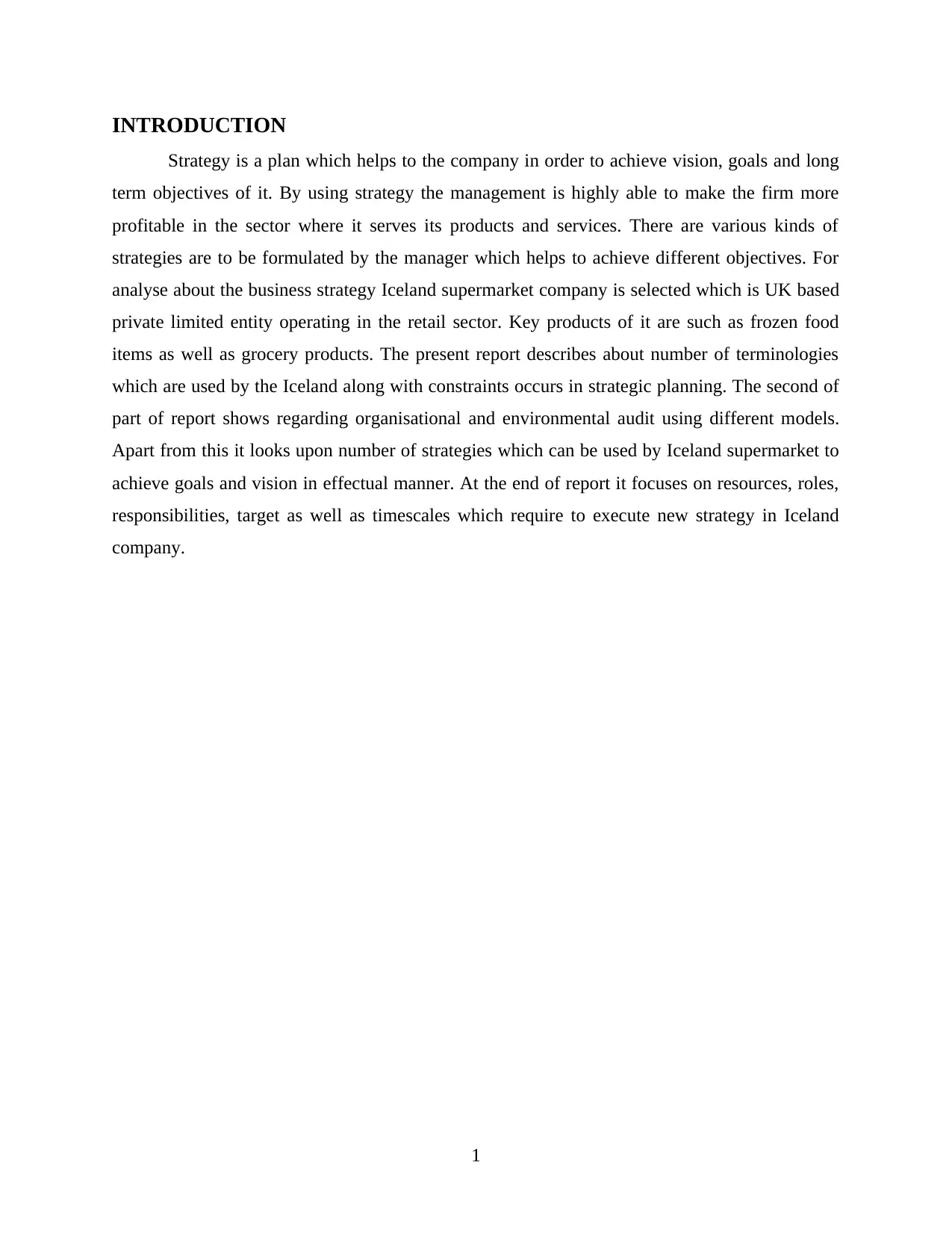
INTRODUCTION
Strategy is a plan which helps to the company in order to achieve vision, goals and long
term objectives of it. By using strategy the management is highly able to make the firm more
profitable in the sector where it serves its products and services. There are various kinds of
strategies are to be formulated by the manager which helps to achieve different objectives. For
analyse about the business strategy Iceland supermarket company is selected which is UK based
private limited entity operating in the retail sector. Key products of it are such as frozen food
items as well as grocery products. The present report describes about number of terminologies
which are used by the Iceland along with constraints occurs in strategic planning. The second of
part of report shows regarding organisational and environmental audit using different models.
Apart from this it looks upon number of strategies which can be used by Iceland supermarket to
achieve goals and vision in effectual manner. At the end of report it focuses on resources, roles,
responsibilities, target as well as timescales which require to execute new strategy in Iceland
company.
1
Strategy is a plan which helps to the company in order to achieve vision, goals and long
term objectives of it. By using strategy the management is highly able to make the firm more
profitable in the sector where it serves its products and services. There are various kinds of
strategies are to be formulated by the manager which helps to achieve different objectives. For
analyse about the business strategy Iceland supermarket company is selected which is UK based
private limited entity operating in the retail sector. Key products of it are such as frozen food
items as well as grocery products. The present report describes about number of terminologies
which are used by the Iceland along with constraints occurs in strategic planning. The second of
part of report shows regarding organisational and environmental audit using different models.
Apart from this it looks upon number of strategies which can be used by Iceland supermarket to
achieve goals and vision in effectual manner. At the end of report it focuses on resources, roles,
responsibilities, target as well as timescales which require to execute new strategy in Iceland
company.
1

TASK 1
1.1 Explaining strategic context and terminologies
2
1.1 Explaining strategic context and terminologies
2
Secure Best Marks with AI Grader
Need help grading? Try our AI Grader for instant feedback on your assignments.
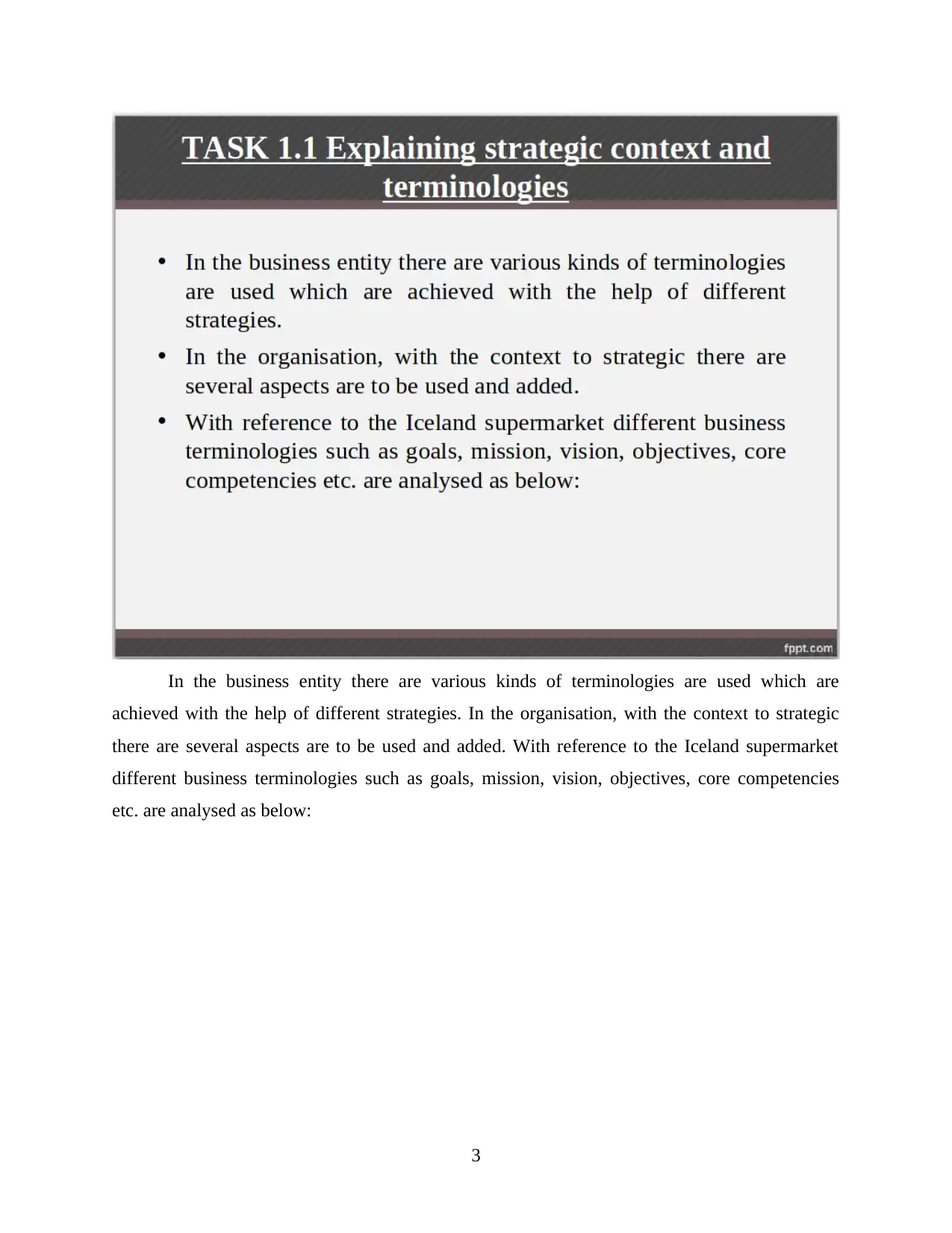
In the business entity there are various kinds of terminologies are used which are
achieved with the help of different strategies. In the organisation, with the context to strategic
there are several aspects are to be used and added. With reference to the Iceland supermarket
different business terminologies such as goals, mission, vision, objectives, core competencies
etc. are analysed as below:
3
achieved with the help of different strategies. In the organisation, with the context to strategic
there are several aspects are to be used and added. With reference to the Iceland supermarket
different business terminologies such as goals, mission, vision, objectives, core competencies
etc. are analysed as below:
3
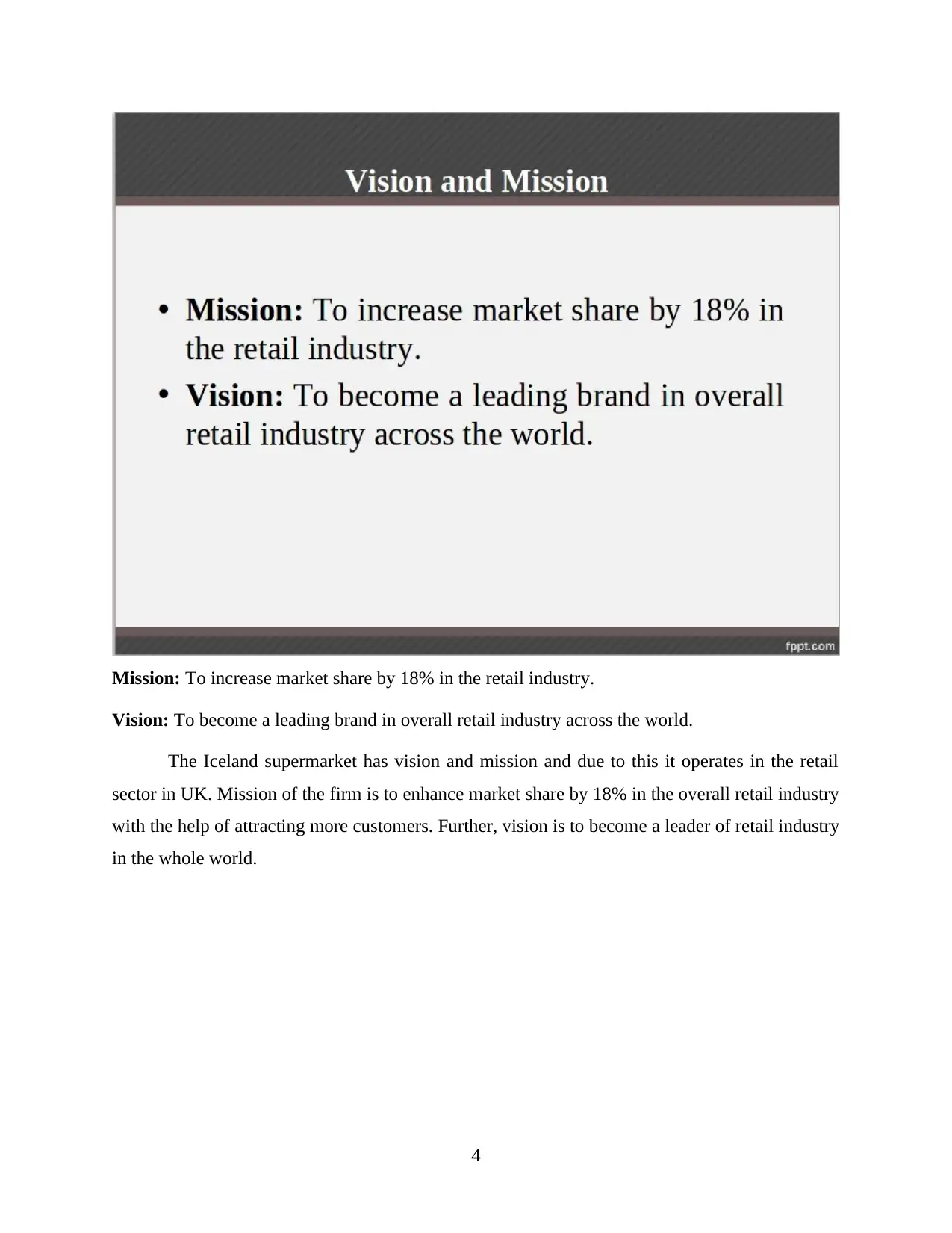
Mission: To increase market share by 18% in the retail industry.
Vision: To become a leading brand in overall retail industry across the world.
The Iceland supermarket has vision and mission and due to this it operates in the retail
sector in UK. Mission of the firm is to enhance market share by 18% in the overall retail industry
with the help of attracting more customers. Further, vision is to become a leader of retail industry
in the whole world.
4
Vision: To become a leading brand in overall retail industry across the world.
The Iceland supermarket has vision and mission and due to this it operates in the retail
sector in UK. Mission of the firm is to enhance market share by 18% in the overall retail industry
with the help of attracting more customers. Further, vision is to become a leader of retail industry
in the whole world.
4
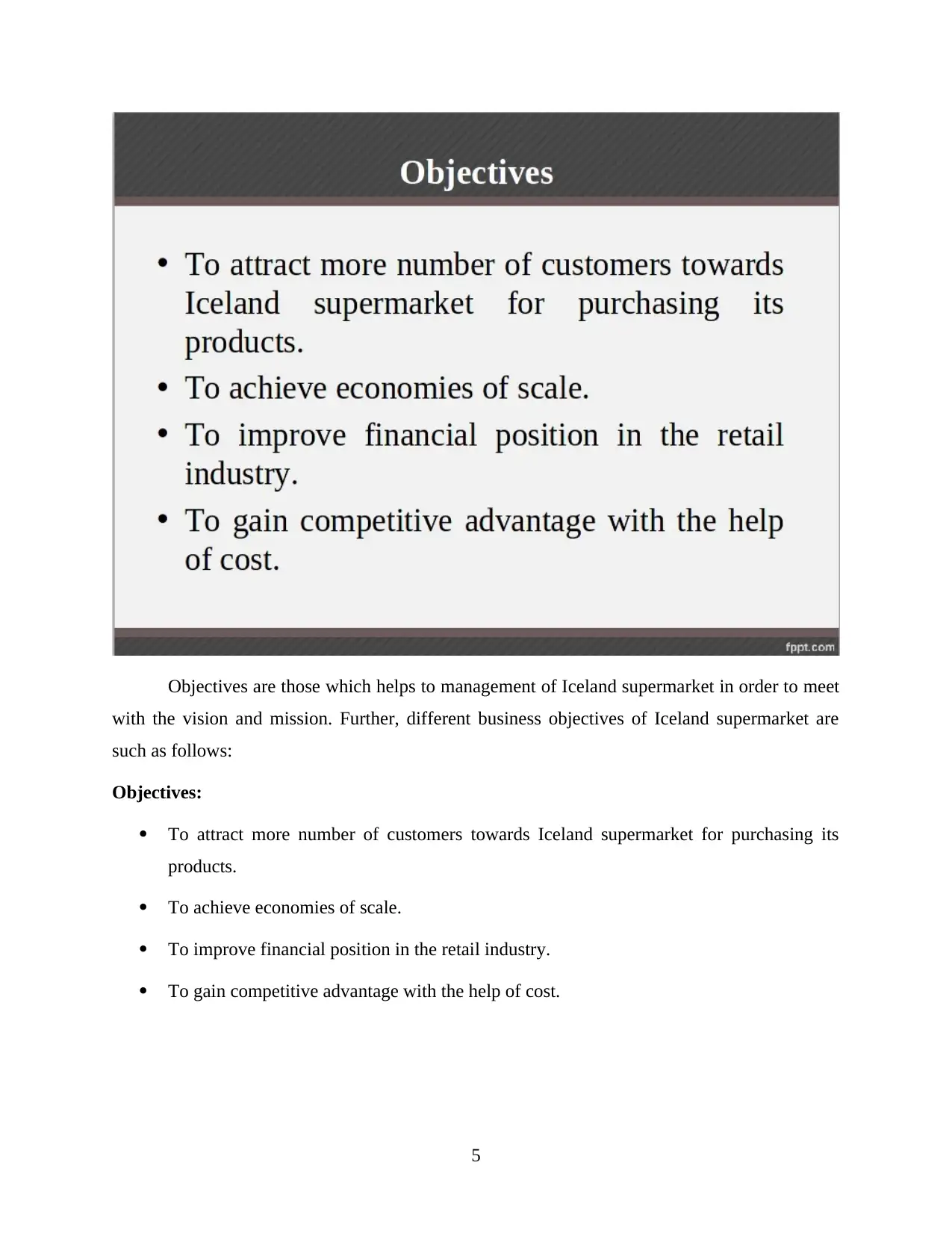
Objectives are those which helps to management of Iceland supermarket in order to meet
with the vision and mission. Further, different business objectives of Iceland supermarket are
such as follows:
Objectives:
To attract more number of customers towards Iceland supermarket for purchasing its
products.
To achieve economies of scale.
To improve financial position in the retail industry.
To gain competitive advantage with the help of cost.
5
with the vision and mission. Further, different business objectives of Iceland supermarket are
such as follows:
Objectives:
To attract more number of customers towards Iceland supermarket for purchasing its
products.
To achieve economies of scale.
To improve financial position in the retail industry.
To gain competitive advantage with the help of cost.
5
Paraphrase This Document
Need a fresh take? Get an instant paraphrase of this document with our AI Paraphraser
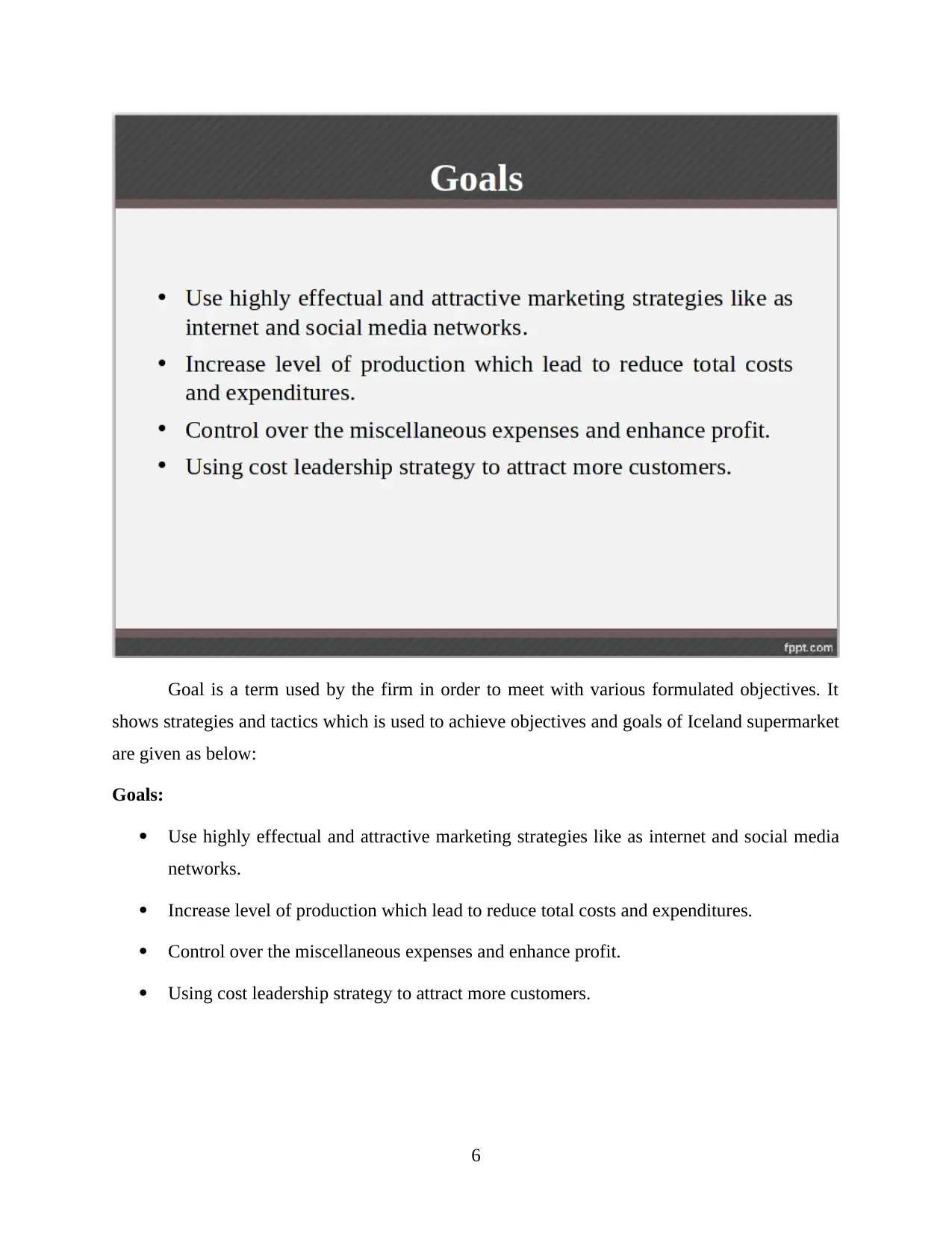
Goal is a term used by the firm in order to meet with various formulated objectives. It
shows strategies and tactics which is used to achieve objectives and goals of Iceland supermarket
are given as below:
Goals:
Use highly effectual and attractive marketing strategies like as internet and social media
networks.
Increase level of production which lead to reduce total costs and expenditures.
Control over the miscellaneous expenses and enhance profit.
Using cost leadership strategy to attract more customers.
6
shows strategies and tactics which is used to achieve objectives and goals of Iceland supermarket
are given as below:
Goals:
Use highly effectual and attractive marketing strategies like as internet and social media
networks.
Increase level of production which lead to reduce total costs and expenditures.
Control over the miscellaneous expenses and enhance profit.
Using cost leadership strategy to attract more customers.
6
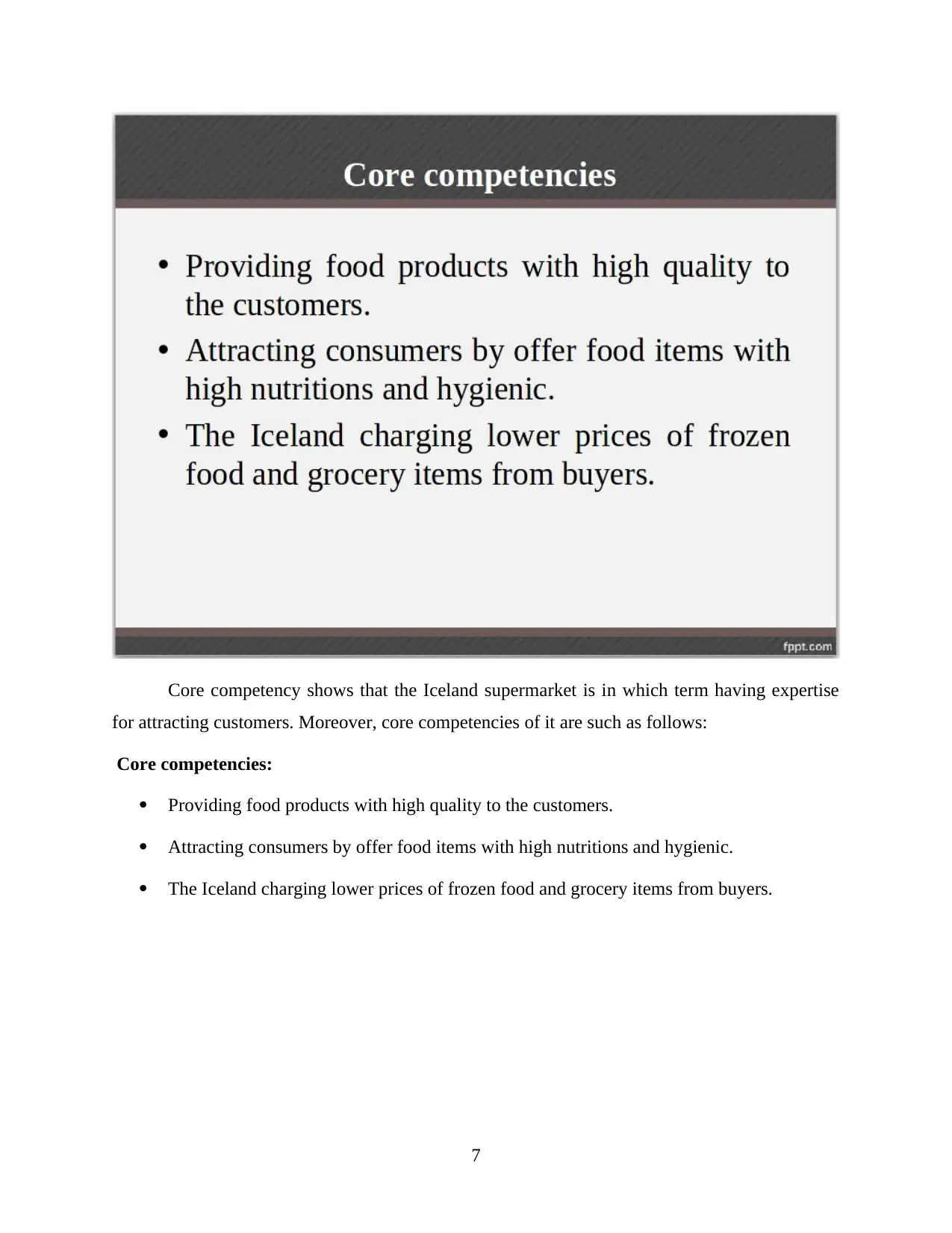
Core competency shows that the Iceland supermarket is in which term having expertise
for attracting customers. Moreover, core competencies of it are such as follows:
Core competencies:
Providing food products with high quality to the customers.
Attracting consumers by offer food items with high nutritions and hygienic.
The Iceland charging lower prices of frozen food and grocery items from buyers.
7
for attracting customers. Moreover, core competencies of it are such as follows:
Core competencies:
Providing food products with high quality to the customers.
Attracting consumers by offer food items with high nutritions and hygienic.
The Iceland charging lower prices of frozen food and grocery items from buyers.
7
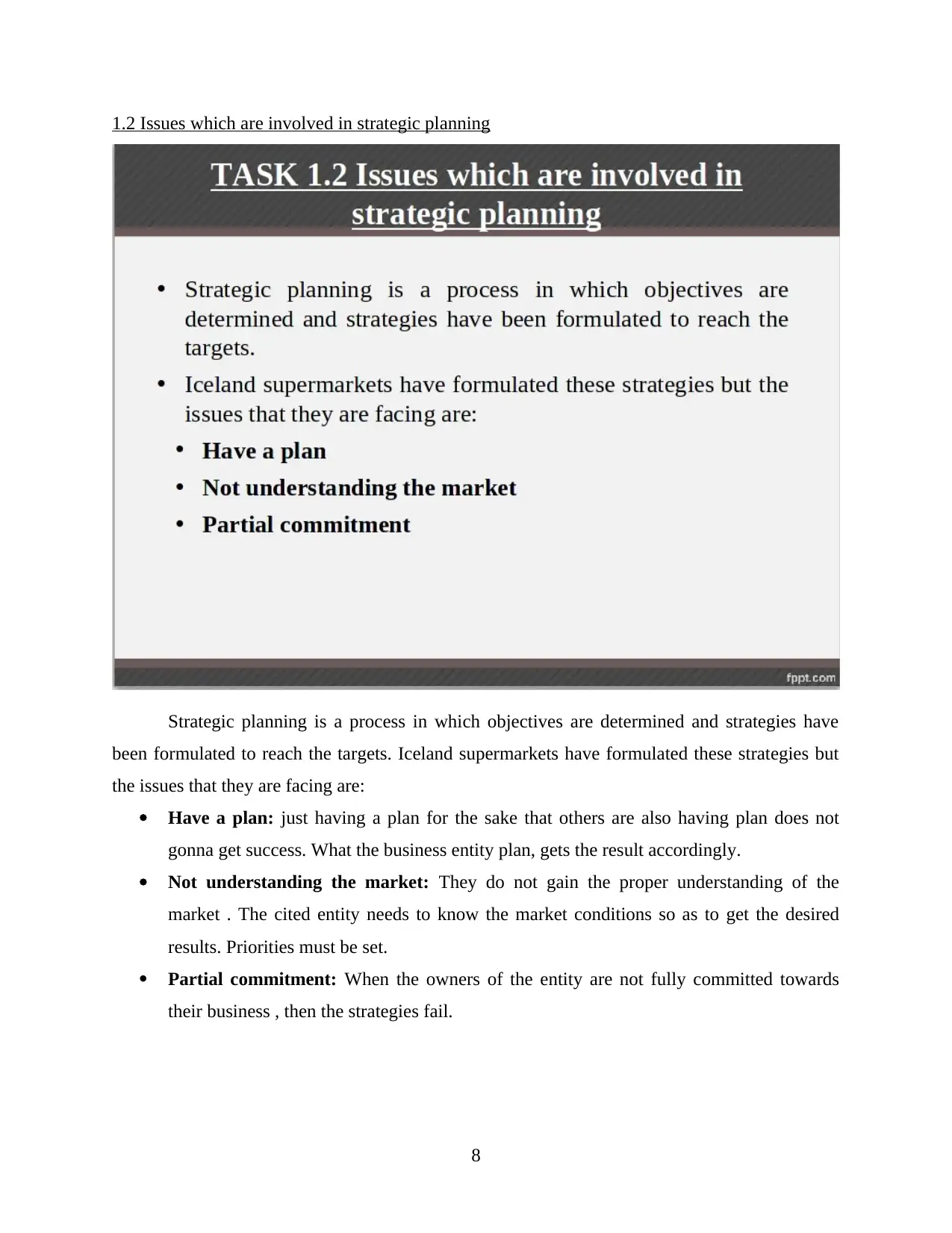
1.2 Issues which are involved in strategic planning
Strategic planning is a process in which objectives are determined and strategies have
been formulated to reach the targets. Iceland supermarkets have formulated these strategies but
the issues that they are facing are:
Have a plan: just having a plan for the sake that others are also having plan does not
gonna get success. What the business entity plan, gets the result accordingly.
Not understanding the market: They do not gain the proper understanding of the
market . The cited entity needs to know the market conditions so as to get the desired
results. Priorities must be set.
Partial commitment: When the owners of the entity are not fully committed towards
their business , then the strategies fail.
8
Strategic planning is a process in which objectives are determined and strategies have
been formulated to reach the targets. Iceland supermarkets have formulated these strategies but
the issues that they are facing are:
Have a plan: just having a plan for the sake that others are also having plan does not
gonna get success. What the business entity plan, gets the result accordingly.
Not understanding the market: They do not gain the proper understanding of the
market . The cited entity needs to know the market conditions so as to get the desired
results. Priorities must be set.
Partial commitment: When the owners of the entity are not fully committed towards
their business , then the strategies fail.
8
Secure Best Marks with AI Grader
Need help grading? Try our AI Grader for instant feedback on your assignments.
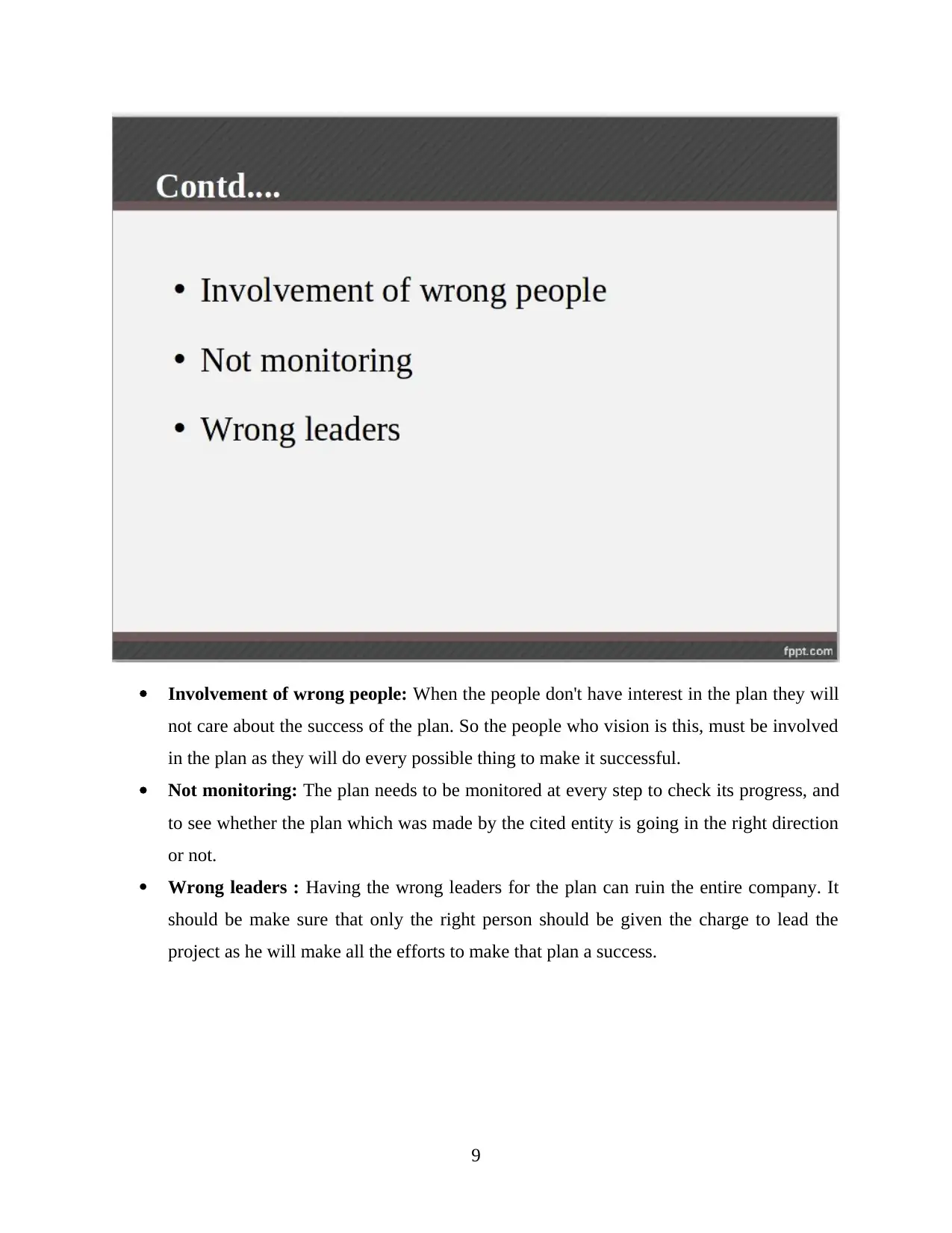
Involvement of wrong people: When the people don't have interest in the plan they will
not care about the success of the plan. So the people who vision is this, must be involved
in the plan as they will do every possible thing to make it successful.
Not monitoring: The plan needs to be monitored at every step to check its progress, and
to see whether the plan which was made by the cited entity is going in the right direction
or not.
Wrong leaders : Having the wrong leaders for the plan can ruin the entire company. It
should be make sure that only the right person should be given the charge to lead the
project as he will make all the efforts to make that plan a success.
9
not care about the success of the plan. So the people who vision is this, must be involved
in the plan as they will do every possible thing to make it successful.
Not monitoring: The plan needs to be monitored at every step to check its progress, and
to see whether the plan which was made by the cited entity is going in the right direction
or not.
Wrong leaders : Having the wrong leaders for the plan can ruin the entire company. It
should be make sure that only the right person should be given the charge to lead the
project as he will make all the efforts to make that plan a success.
9
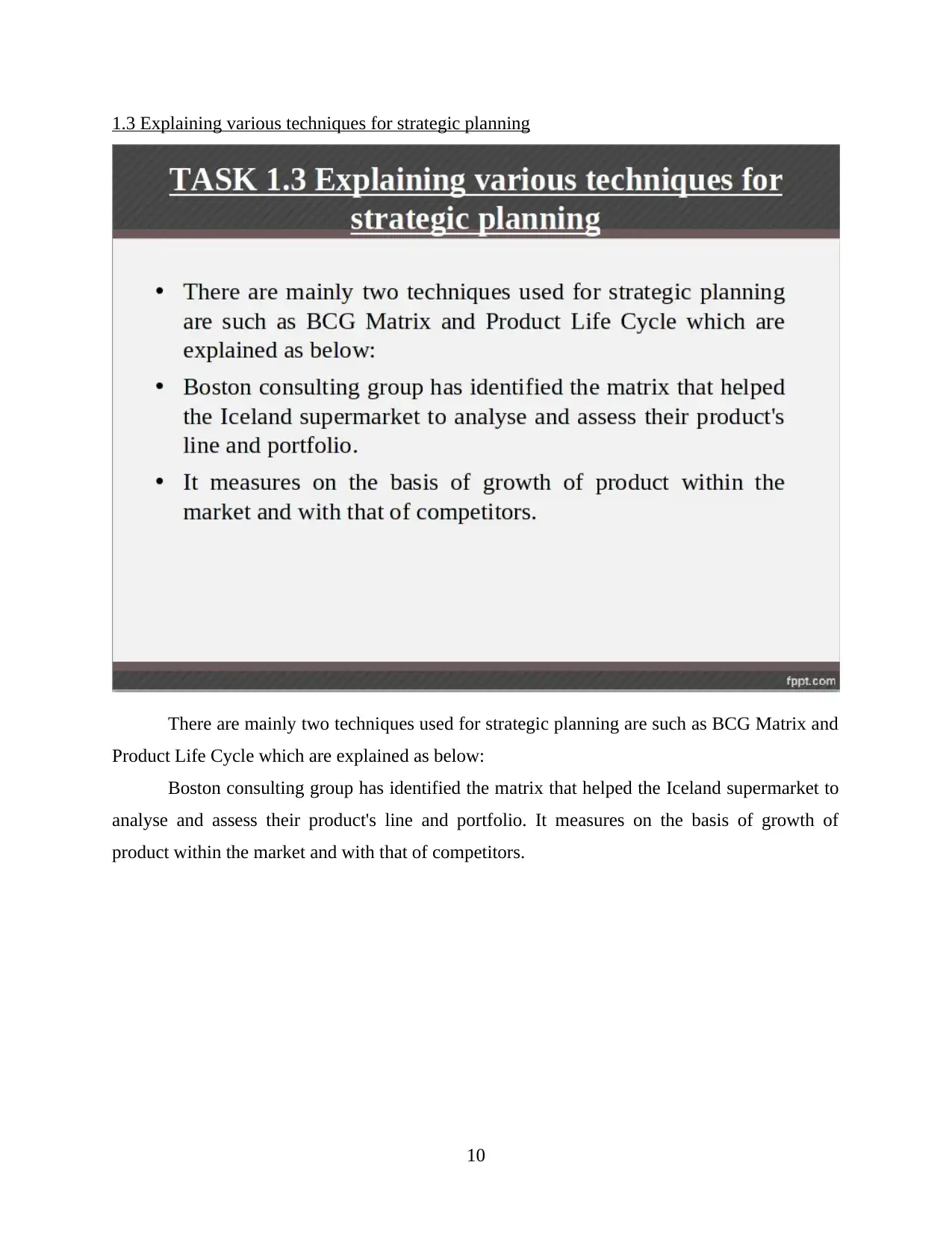
1.3 Explaining various techniques for strategic planning
There are mainly two techniques used for strategic planning are such as BCG Matrix and
Product Life Cycle which are explained as below:
Boston consulting group has identified the matrix that helped the Iceland supermarket to
analyse and assess their product's line and portfolio. It measures on the basis of growth of
product within the market and with that of competitors.
10
There are mainly two techniques used for strategic planning are such as BCG Matrix and
Product Life Cycle which are explained as below:
Boston consulting group has identified the matrix that helped the Iceland supermarket to
analyse and assess their product's line and portfolio. It measures on the basis of growth of
product within the market and with that of competitors.
10
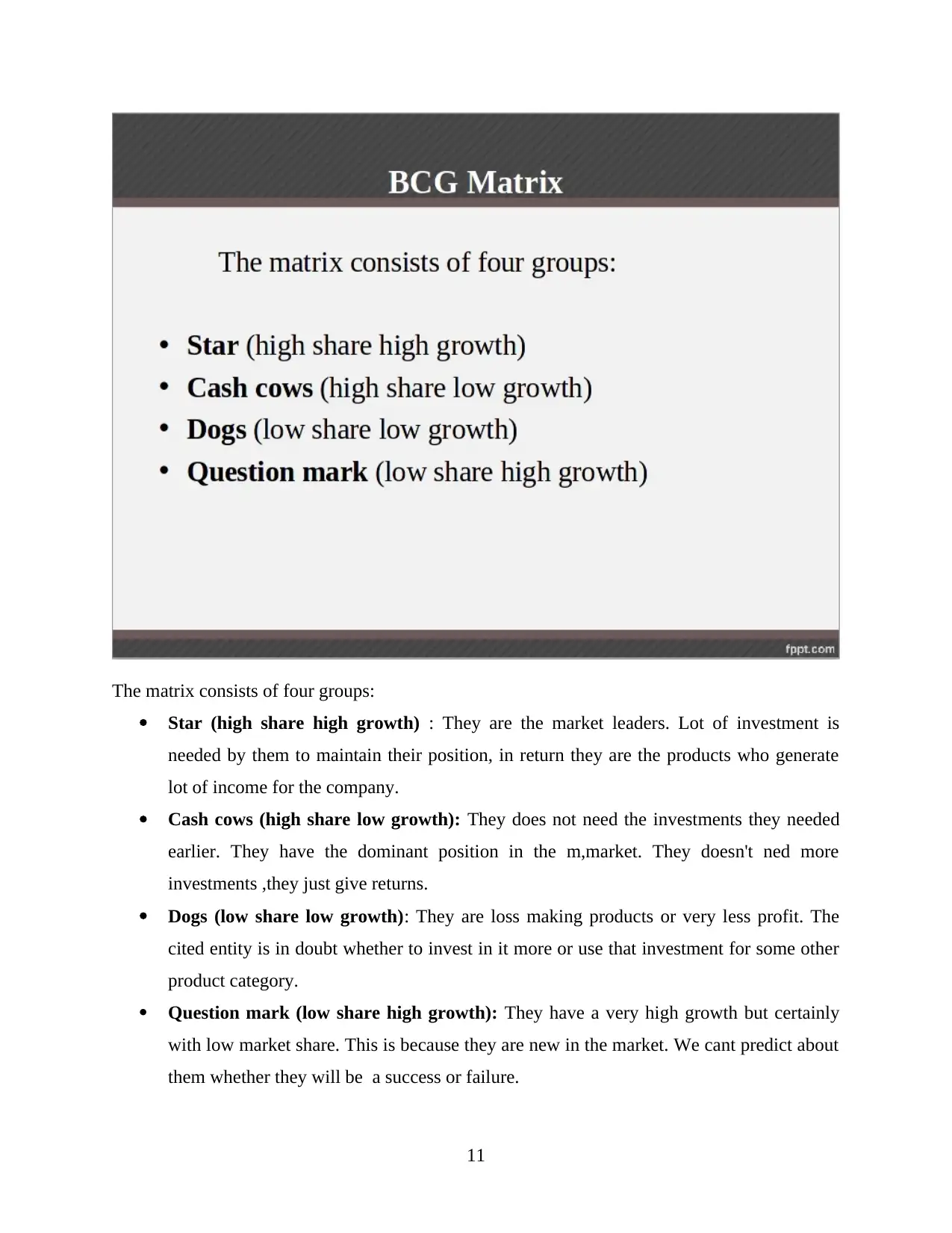
The matrix consists of four groups:
Star (high share high growth) : They are the market leaders. Lot of investment is
needed by them to maintain their position, in return they are the products who generate
lot of income for the company.
Cash cows (high share low growth): They does not need the investments they needed
earlier. They have the dominant position in the m,market. They doesn't ned more
investments ,they just give returns.
Dogs (low share low growth): They are loss making products or very less profit. The
cited entity is in doubt whether to invest in it more or use that investment for some other
product category.
Question mark (low share high growth): They have a very high growth but certainly
with low market share. This is because they are new in the market. We cant predict about
them whether they will be a success or failure.
11
Star (high share high growth) : They are the market leaders. Lot of investment is
needed by them to maintain their position, in return they are the products who generate
lot of income for the company.
Cash cows (high share low growth): They does not need the investments they needed
earlier. They have the dominant position in the m,market. They doesn't ned more
investments ,they just give returns.
Dogs (low share low growth): They are loss making products or very less profit. The
cited entity is in doubt whether to invest in it more or use that investment for some other
product category.
Question mark (low share high growth): They have a very high growth but certainly
with low market share. This is because they are new in the market. We cant predict about
them whether they will be a success or failure.
11
Paraphrase This Document
Need a fresh take? Get an instant paraphrase of this document with our AI Paraphraser
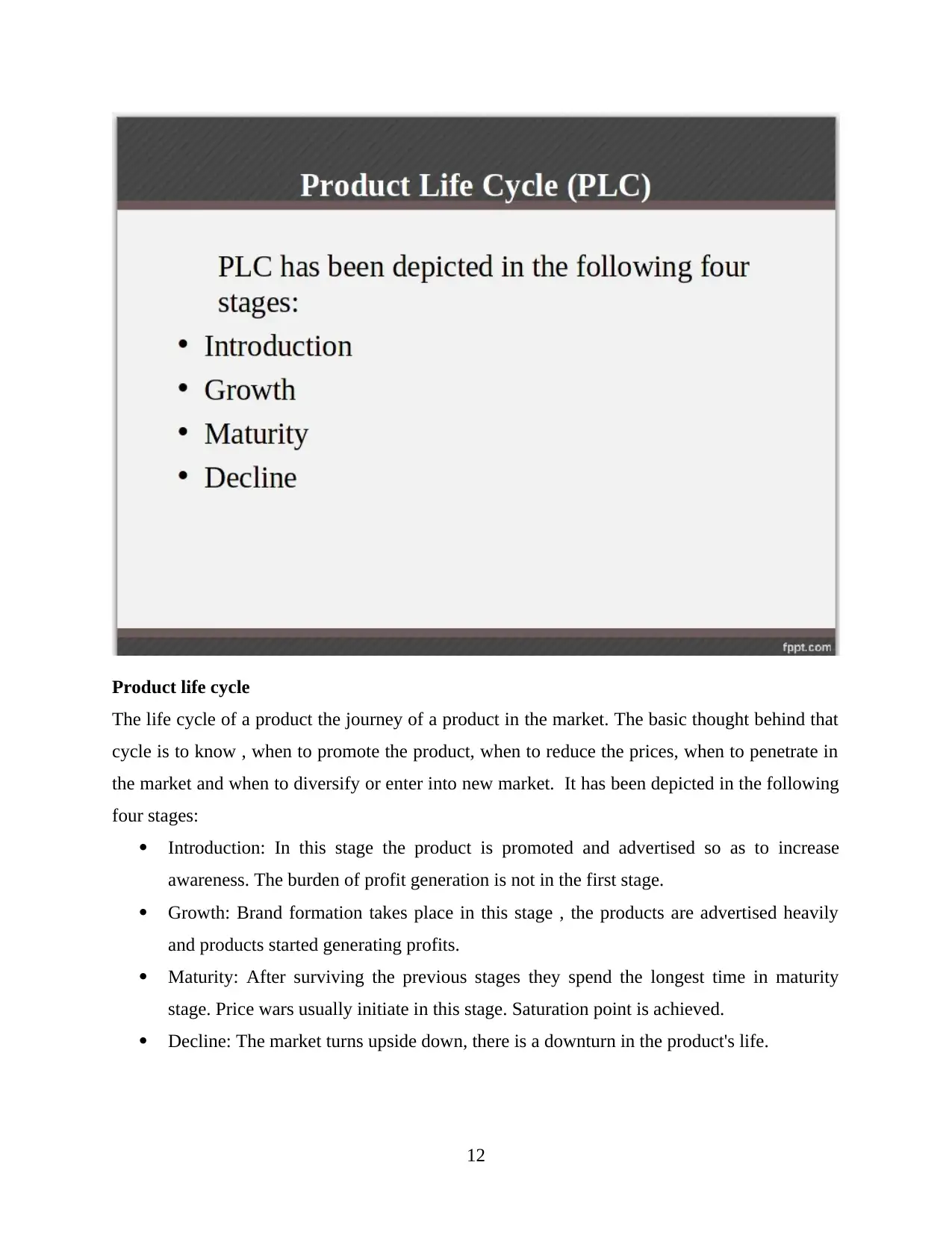
Product life cycle
The life cycle of a product the journey of a product in the market. The basic thought behind that
cycle is to know , when to promote the product, when to reduce the prices, when to penetrate in
the market and when to diversify or enter into new market. It has been depicted in the following
four stages:
Introduction: In this stage the product is promoted and advertised so as to increase
awareness. The burden of profit generation is not in the first stage.
Growth: Brand formation takes place in this stage , the products are advertised heavily
and products started generating profits.
Maturity: After surviving the previous stages they spend the longest time in maturity
stage. Price wars usually initiate in this stage. Saturation point is achieved.
Decline: The market turns upside down, there is a downturn in the product's life.
12
The life cycle of a product the journey of a product in the market. The basic thought behind that
cycle is to know , when to promote the product, when to reduce the prices, when to penetrate in
the market and when to diversify or enter into new market. It has been depicted in the following
four stages:
Introduction: In this stage the product is promoted and advertised so as to increase
awareness. The burden of profit generation is not in the first stage.
Growth: Brand formation takes place in this stage , the products are advertised heavily
and products started generating profits.
Maturity: After surviving the previous stages they spend the longest time in maturity
stage. Price wars usually initiate in this stage. Saturation point is achieved.
Decline: The market turns upside down, there is a downturn in the product's life.
12
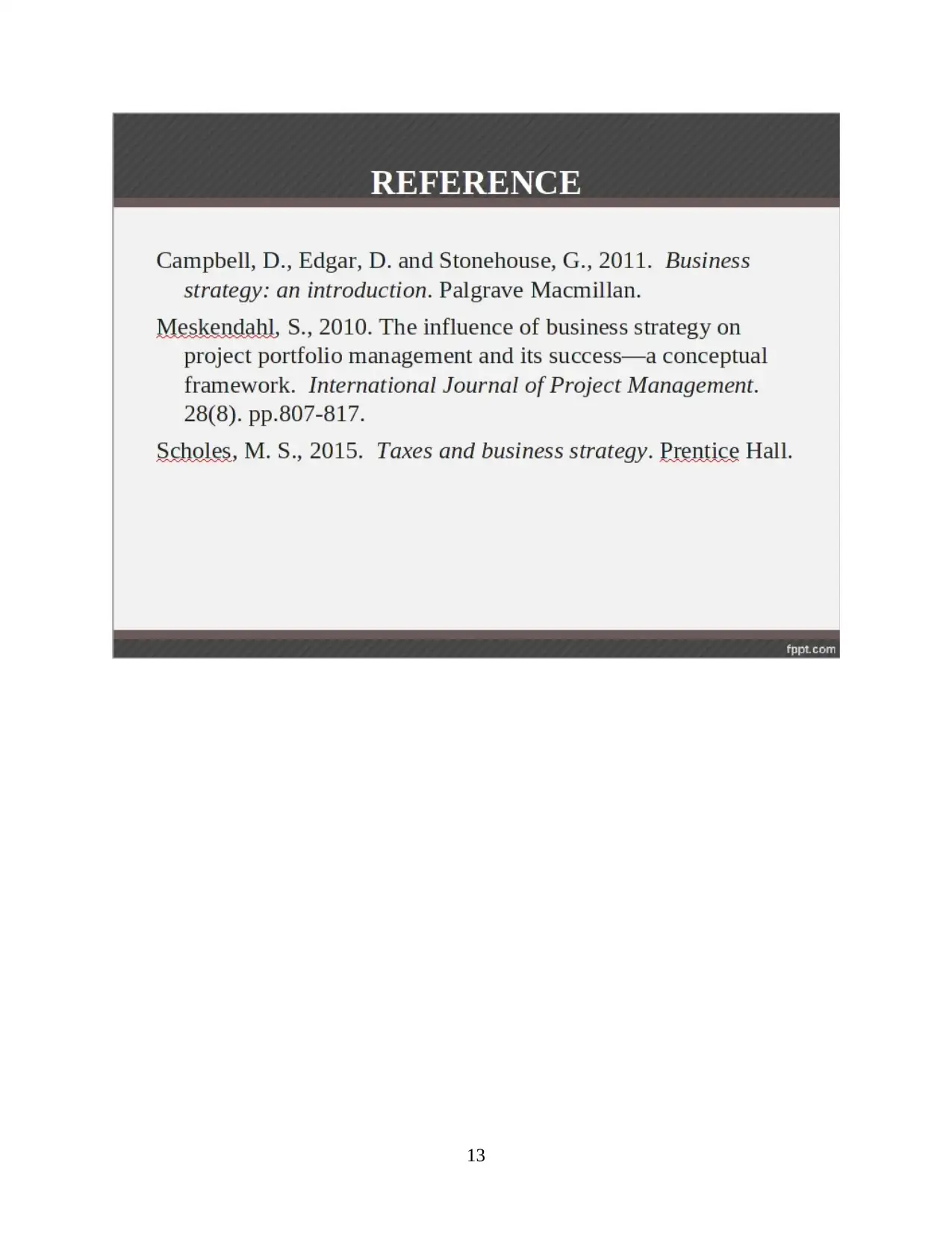
13
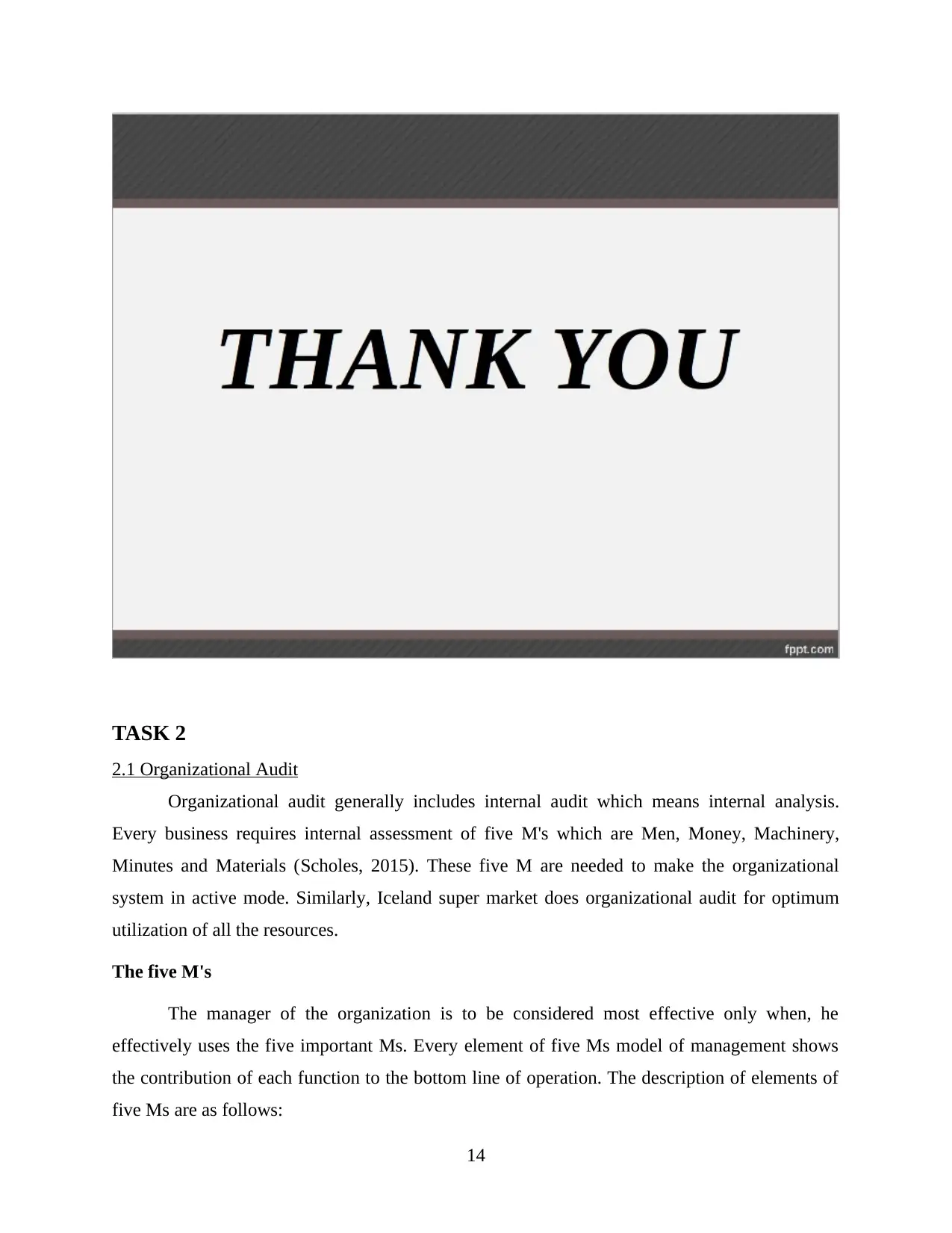
TASK 2
2.1 Organizational Audit
Organizational audit generally includes internal audit which means internal analysis.
Every business requires internal assessment of five M's which are Men, Money, Machinery,
Minutes and Materials (Scholes, 2015). These five M are needed to make the organizational
system in active mode. Similarly, Iceland super market does organizational audit for optimum
utilization of all the resources.
The five M's
The manager of the organization is to be considered most effective only when, he
effectively uses the five important Ms. Every element of five Ms model of management shows
the contribution of each function to the bottom line of operation. The description of elements of
five Ms are as follows:
14
2.1 Organizational Audit
Organizational audit generally includes internal audit which means internal analysis.
Every business requires internal assessment of five M's which are Men, Money, Machinery,
Minutes and Materials (Scholes, 2015). These five M are needed to make the organizational
system in active mode. Similarly, Iceland super market does organizational audit for optimum
utilization of all the resources.
The five M's
The manager of the organization is to be considered most effective only when, he
effectively uses the five important Ms. Every element of five Ms model of management shows
the contribution of each function to the bottom line of operation. The description of elements of
five Ms are as follows:
14
Secure Best Marks with AI Grader
Need help grading? Try our AI Grader for instant feedback on your assignments.

Man (Employee/Labour) – Every organization needs manpower for getting the work
done. These are the very big support to the management, as they work hard and helps in
generating more effective results (Teece, 2010). So, it becomes responsibility of business
that they ensure the satisfaction level of employees and workers. Satisfaction is required
in them because as they are satisfied they will give their best efforts to the organizational
activities.
Money (Finance) – Money is the most important and basic element in the organization
which requires every where. The managers of Iceland make sure that there must be
effective use of finance. It should be used at right time with right amount for getting more
benefits. The sufficient arrangement of finance is required for reducing the chances of
shortage of money. So that, the business activities are not get hampered.
Machinery (Equipments) – Organization uses tangible as well as intangible equipments
(machines) in the operations. These are the things which makes the work more easy and
in effective way. Like computers, now a days this becomes the basic machine which is
must in every type of organization whether small, medium or large. Iceland also uses
various types of equipments such as bar code reader, biometric machine, computers,
printers and so on.
Methods (Process) – The method or process that has adopted by the organization puts
large impact on those activities which are going through that process. The flexible
method helps in taking decisions in the dynamic business environment and can be
cahange easily.
15
done. These are the very big support to the management, as they work hard and helps in
generating more effective results (Teece, 2010). So, it becomes responsibility of business
that they ensure the satisfaction level of employees and workers. Satisfaction is required
in them because as they are satisfied they will give their best efforts to the organizational
activities.
Money (Finance) – Money is the most important and basic element in the organization
which requires every where. The managers of Iceland make sure that there must be
effective use of finance. It should be used at right time with right amount for getting more
benefits. The sufficient arrangement of finance is required for reducing the chances of
shortage of money. So that, the business activities are not get hampered.
Machinery (Equipments) – Organization uses tangible as well as intangible equipments
(machines) in the operations. These are the things which makes the work more easy and
in effective way. Like computers, now a days this becomes the basic machine which is
must in every type of organization whether small, medium or large. Iceland also uses
various types of equipments such as bar code reader, biometric machine, computers,
printers and so on.
Methods (Process) – The method or process that has adopted by the organization puts
large impact on those activities which are going through that process. The flexible
method helps in taking decisions in the dynamic business environment and can be
cahange easily.
15
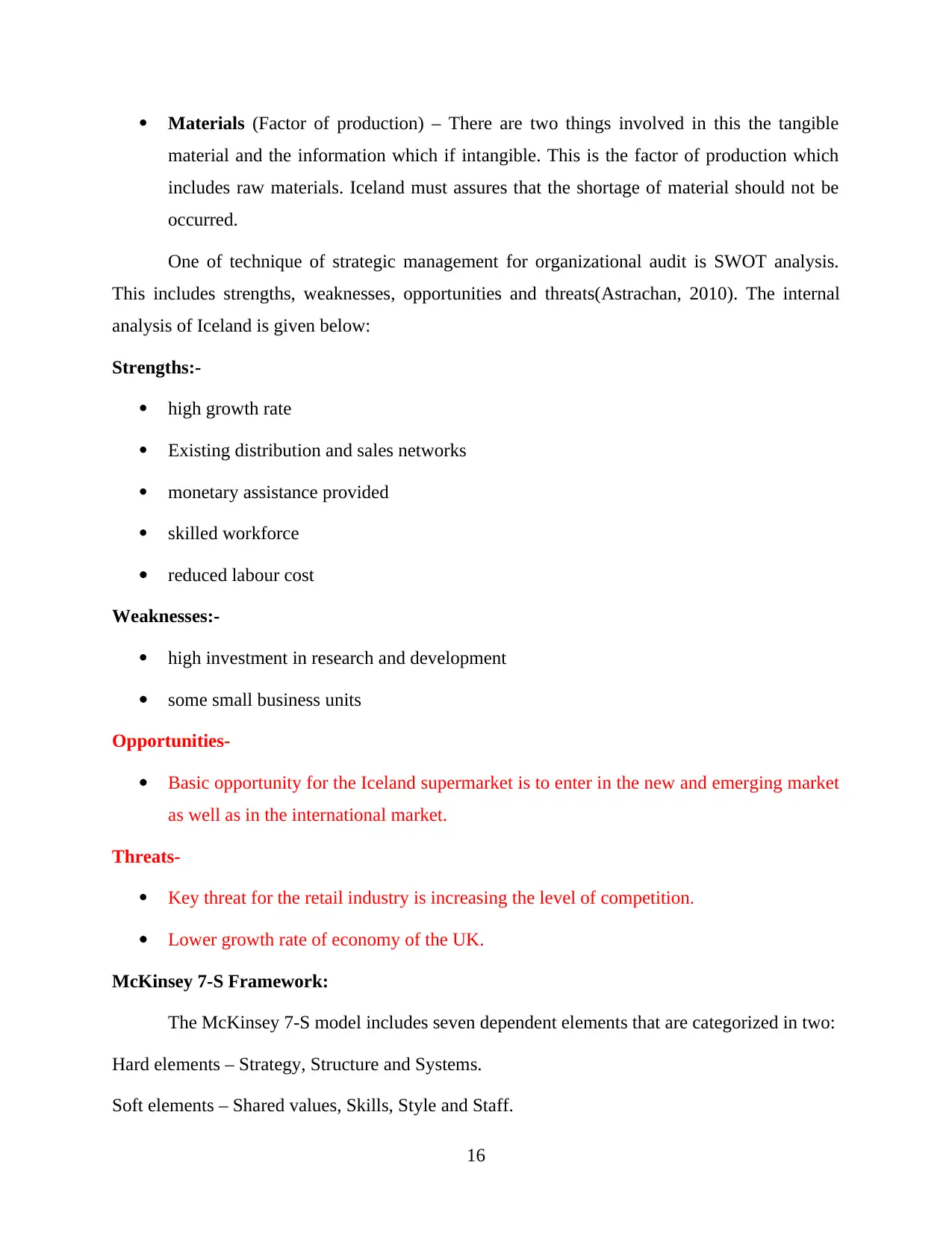
Materials (Factor of production) – There are two things involved in this the tangible
material and the information which if intangible. This is the factor of production which
includes raw materials. Iceland must assures that the shortage of material should not be
occurred.
One of technique of strategic management for organizational audit is SWOT analysis.
This includes strengths, weaknesses, opportunities and threats(Astrachan, 2010). The internal
analysis of Iceland is given below:
Strengths:-
high growth rate
Existing distribution and sales networks
monetary assistance provided
skilled workforce
reduced labour cost
Weaknesses:-
high investment in research and development
some small business units
Opportunities-
Basic opportunity for the Iceland supermarket is to enter in the new and emerging market
as well as in the international market.
Threats-
Key threat for the retail industry is increasing the level of competition.
Lower growth rate of economy of the UK.
McKinsey 7-S Framework:
The McKinsey 7-S model includes seven dependent elements that are categorized in two:
Hard elements – Strategy, Structure and Systems.
Soft elements – Shared values, Skills, Style and Staff.
16
material and the information which if intangible. This is the factor of production which
includes raw materials. Iceland must assures that the shortage of material should not be
occurred.
One of technique of strategic management for organizational audit is SWOT analysis.
This includes strengths, weaknesses, opportunities and threats(Astrachan, 2010). The internal
analysis of Iceland is given below:
Strengths:-
high growth rate
Existing distribution and sales networks
monetary assistance provided
skilled workforce
reduced labour cost
Weaknesses:-
high investment in research and development
some small business units
Opportunities-
Basic opportunity for the Iceland supermarket is to enter in the new and emerging market
as well as in the international market.
Threats-
Key threat for the retail industry is increasing the level of competition.
Lower growth rate of economy of the UK.
McKinsey 7-S Framework:
The McKinsey 7-S model includes seven dependent elements that are categorized in two:
Hard elements – Strategy, Structure and Systems.
Soft elements – Shared values, Skills, Style and Staff.
16
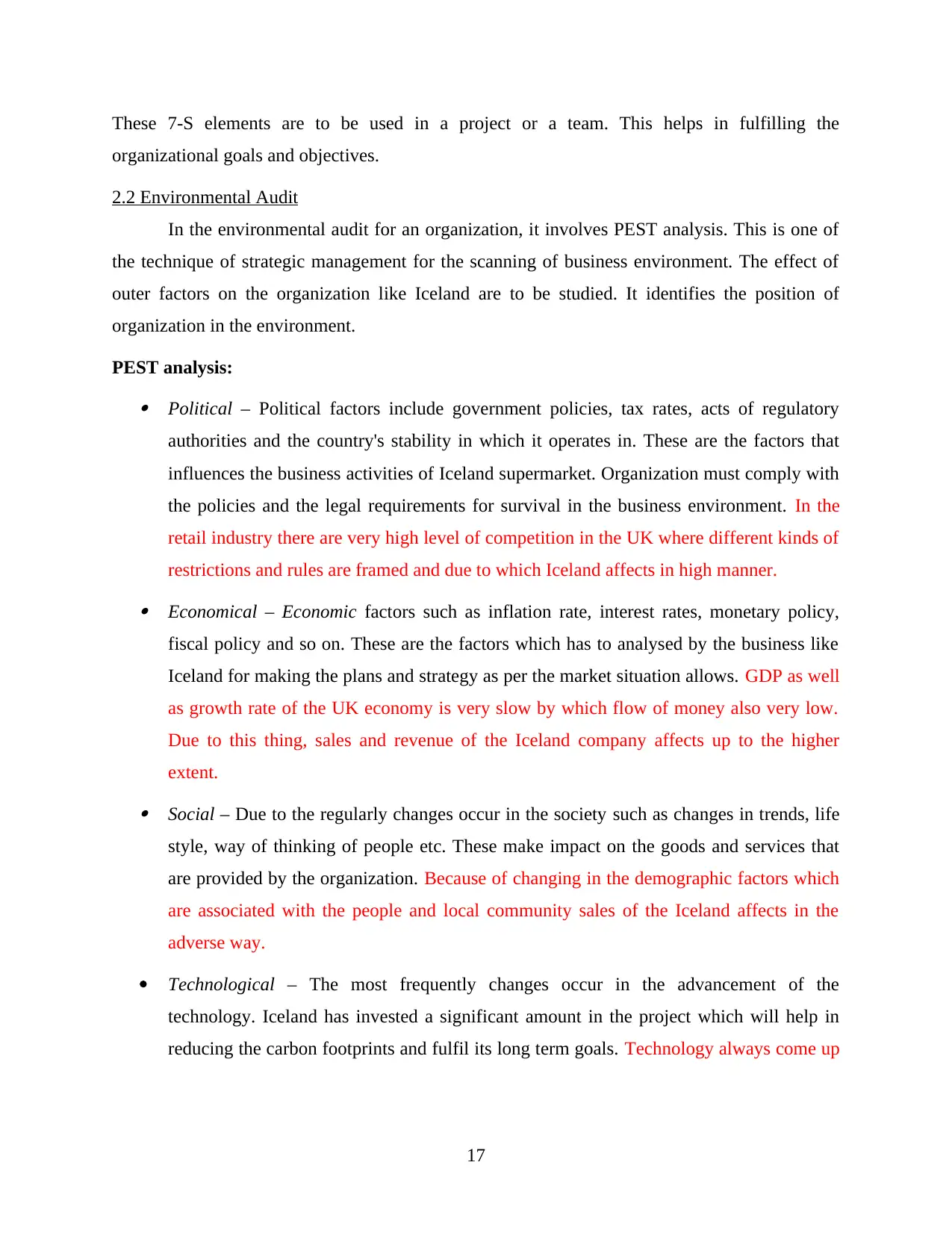
These 7-S elements are to be used in a project or a team. This helps in fulfilling the
organizational goals and objectives.
2.2 Environmental Audit
In the environmental audit for an organization, it involves PEST analysis. This is one of
the technique of strategic management for the scanning of business environment. The effect of
outer factors on the organization like Iceland are to be studied. It identifies the position of
organization in the environment.
PEST analysis: Political – Political factors include government policies, tax rates, acts of regulatory
authorities and the country's stability in which it operates in. These are the factors that
influences the business activities of Iceland supermarket. Organization must comply with
the policies and the legal requirements for survival in the business environment. In the
retail industry there are very high level of competition in the UK where different kinds of
restrictions and rules are framed and due to which Iceland affects in high manner. Economical – Economic factors such as inflation rate, interest rates, monetary policy,
fiscal policy and so on. These are the factors which has to analysed by the business like
Iceland for making the plans and strategy as per the market situation allows. GDP as well
as growth rate of the UK economy is very slow by which flow of money also very low.
Due to this thing, sales and revenue of the Iceland company affects up to the higher
extent. Social – Due to the regularly changes occur in the society such as changes in trends, life
style, way of thinking of people etc. These make impact on the goods and services that
are provided by the organization. Because of changing in the demographic factors which
are associated with the people and local community sales of the Iceland affects in the
adverse way.
Technological – The most frequently changes occur in the advancement of the
technology. Iceland has invested a significant amount in the project which will help in
reducing the carbon footprints and fulfil its long term goals. Technology always come up
17
organizational goals and objectives.
2.2 Environmental Audit
In the environmental audit for an organization, it involves PEST analysis. This is one of
the technique of strategic management for the scanning of business environment. The effect of
outer factors on the organization like Iceland are to be studied. It identifies the position of
organization in the environment.
PEST analysis: Political – Political factors include government policies, tax rates, acts of regulatory
authorities and the country's stability in which it operates in. These are the factors that
influences the business activities of Iceland supermarket. Organization must comply with
the policies and the legal requirements for survival in the business environment. In the
retail industry there are very high level of competition in the UK where different kinds of
restrictions and rules are framed and due to which Iceland affects in high manner. Economical – Economic factors such as inflation rate, interest rates, monetary policy,
fiscal policy and so on. These are the factors which has to analysed by the business like
Iceland for making the plans and strategy as per the market situation allows. GDP as well
as growth rate of the UK economy is very slow by which flow of money also very low.
Due to this thing, sales and revenue of the Iceland company affects up to the higher
extent. Social – Due to the regularly changes occur in the society such as changes in trends, life
style, way of thinking of people etc. These make impact on the goods and services that
are provided by the organization. Because of changing in the demographic factors which
are associated with the people and local community sales of the Iceland affects in the
adverse way.
Technological – The most frequently changes occur in the advancement of the
technology. Iceland has invested a significant amount in the project which will help in
reducing the carbon footprints and fulfil its long term goals. Technology always come up
17
Paraphrase This Document
Need a fresh take? Get an instant paraphrase of this document with our AI Paraphraser
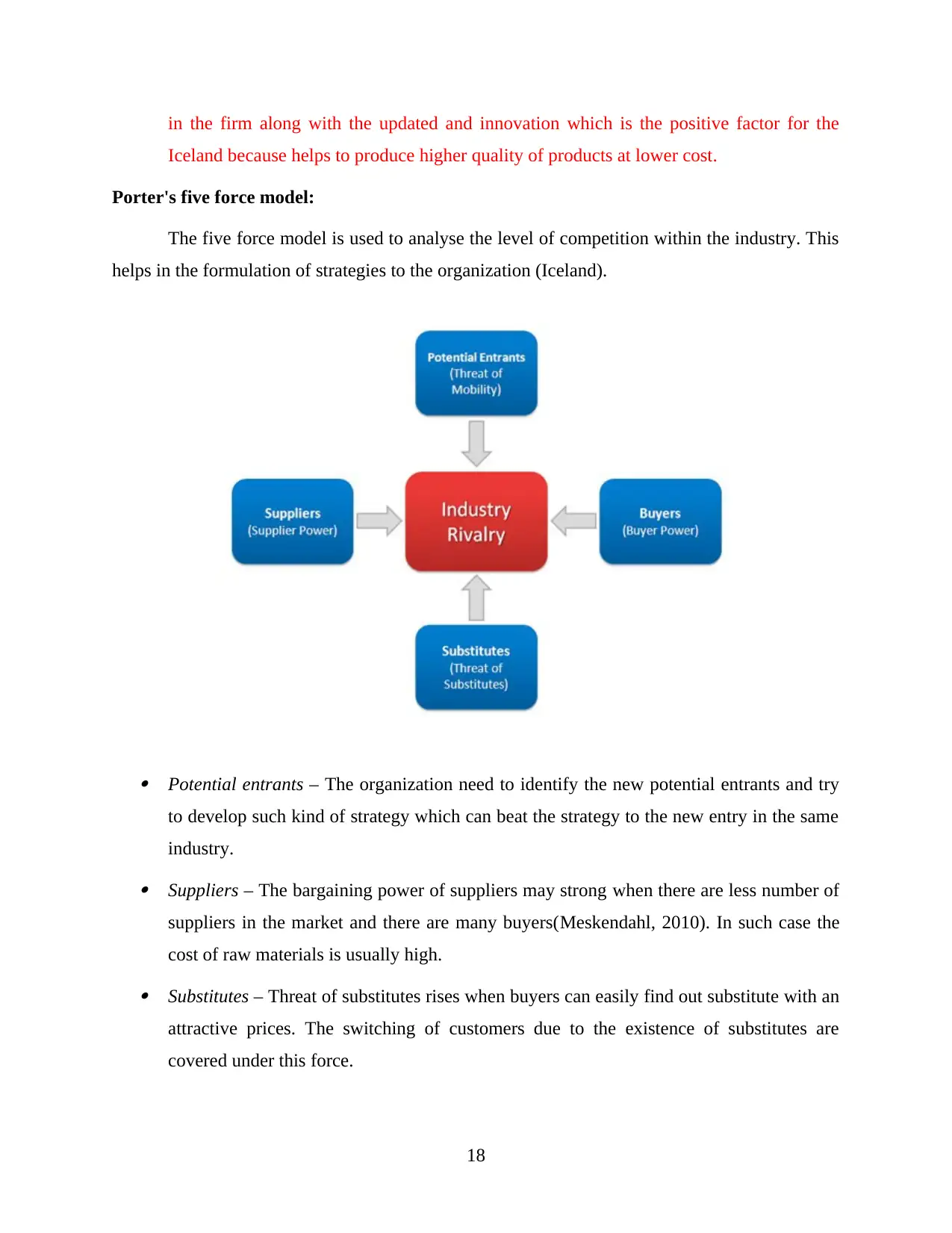
in the firm along with the updated and innovation which is the positive factor for the
Iceland because helps to produce higher quality of products at lower cost.
Porter's five force model:
The five force model is used to analyse the level of competition within the industry. This
helps in the formulation of strategies to the organization (Iceland).
Potential entrants – The organization need to identify the new potential entrants and try
to develop such kind of strategy which can beat the strategy to the new entry in the same
industry. Suppliers – The bargaining power of suppliers may strong when there are less number of
suppliers in the market and there are many buyers(Meskendahl, 2010). In such case the
cost of raw materials is usually high. Substitutes – Threat of substitutes rises when buyers can easily find out substitute with an
attractive prices. The switching of customers due to the existence of substitutes are
covered under this force.
18
Iceland because helps to produce higher quality of products at lower cost.
Porter's five force model:
The five force model is used to analyse the level of competition within the industry. This
helps in the formulation of strategies to the organization (Iceland).
Potential entrants – The organization need to identify the new potential entrants and try
to develop such kind of strategy which can beat the strategy to the new entry in the same
industry. Suppliers – The bargaining power of suppliers may strong when there are less number of
suppliers in the market and there are many buyers(Meskendahl, 2010). In such case the
cost of raw materials is usually high. Substitutes – Threat of substitutes rises when buyers can easily find out substitute with an
attractive prices. The switching of customers due to the existence of substitutes are
covered under this force.
18
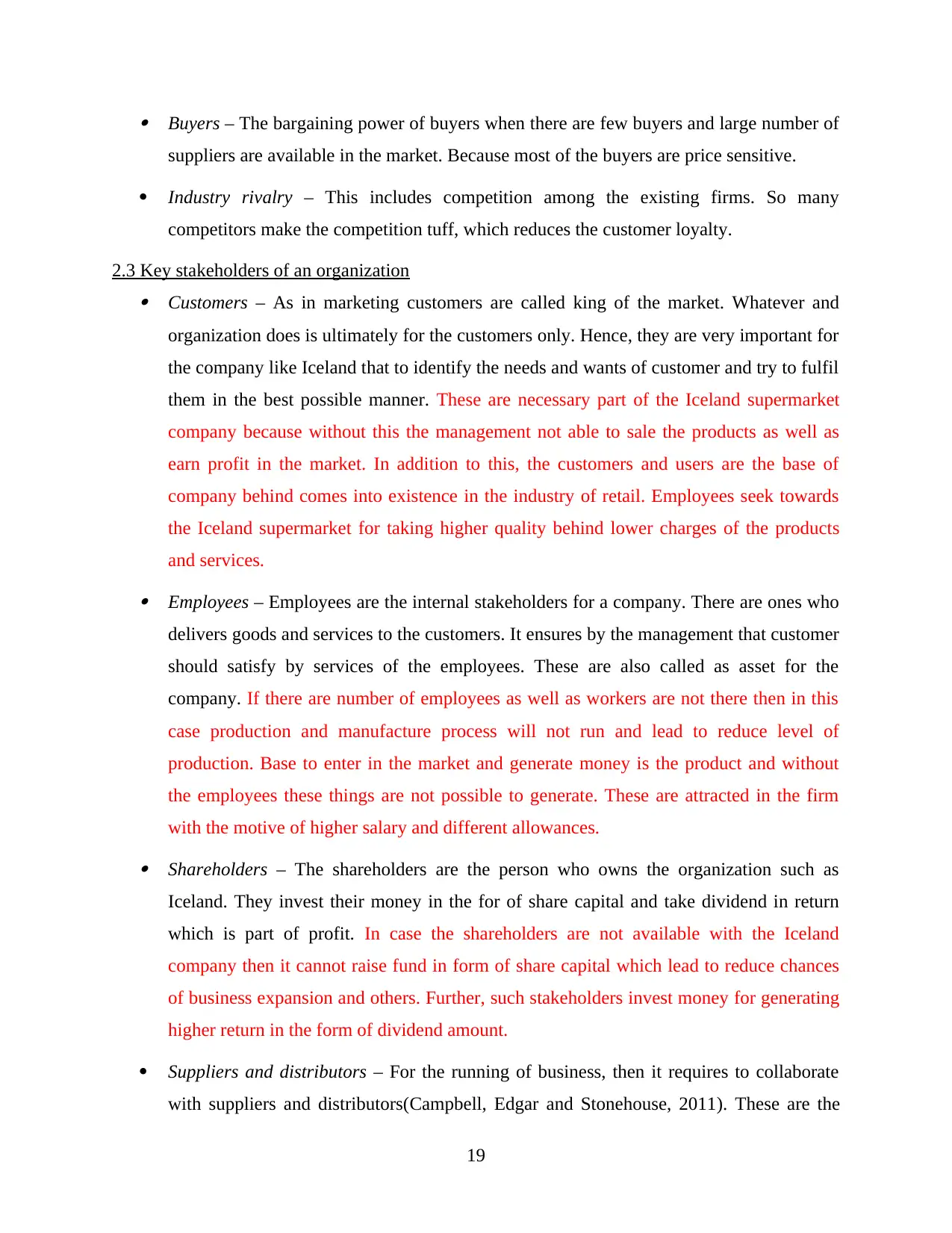
Buyers – The bargaining power of buyers when there are few buyers and large number of
suppliers are available in the market. Because most of the buyers are price sensitive.
Industry rivalry – This includes competition among the existing firms. So many
competitors make the competition tuff, which reduces the customer loyalty.
2.3 Key stakeholders of an organization Customers – As in marketing customers are called king of the market. Whatever and
organization does is ultimately for the customers only. Hence, they are very important for
the company like Iceland that to identify the needs and wants of customer and try to fulfil
them in the best possible manner. These are necessary part of the Iceland supermarket
company because without this the management not able to sale the products as well as
earn profit in the market. In addition to this, the customers and users are the base of
company behind comes into existence in the industry of retail. Employees seek towards
the Iceland supermarket for taking higher quality behind lower charges of the products
and services. Employees – Employees are the internal stakeholders for a company. There are ones who
delivers goods and services to the customers. It ensures by the management that customer
should satisfy by services of the employees. These are also called as asset for the
company. If there are number of employees as well as workers are not there then in this
case production and manufacture process will not run and lead to reduce level of
production. Base to enter in the market and generate money is the product and without
the employees these things are not possible to generate. These are attracted in the firm
with the motive of higher salary and different allowances. Shareholders – The shareholders are the person who owns the organization such as
Iceland. They invest their money in the for of share capital and take dividend in return
which is part of profit. In case the shareholders are not available with the Iceland
company then it cannot raise fund in form of share capital which lead to reduce chances
of business expansion and others. Further, such stakeholders invest money for generating
higher return in the form of dividend amount.
Suppliers and distributors – For the running of business, then it requires to collaborate
with suppliers and distributors(Campbell, Edgar and Stonehouse, 2011). These are the
19
suppliers are available in the market. Because most of the buyers are price sensitive.
Industry rivalry – This includes competition among the existing firms. So many
competitors make the competition tuff, which reduces the customer loyalty.
2.3 Key stakeholders of an organization Customers – As in marketing customers are called king of the market. Whatever and
organization does is ultimately for the customers only. Hence, they are very important for
the company like Iceland that to identify the needs and wants of customer and try to fulfil
them in the best possible manner. These are necessary part of the Iceland supermarket
company because without this the management not able to sale the products as well as
earn profit in the market. In addition to this, the customers and users are the base of
company behind comes into existence in the industry of retail. Employees seek towards
the Iceland supermarket for taking higher quality behind lower charges of the products
and services. Employees – Employees are the internal stakeholders for a company. There are ones who
delivers goods and services to the customers. It ensures by the management that customer
should satisfy by services of the employees. These are also called as asset for the
company. If there are number of employees as well as workers are not there then in this
case production and manufacture process will not run and lead to reduce level of
production. Base to enter in the market and generate money is the product and without
the employees these things are not possible to generate. These are attracted in the firm
with the motive of higher salary and different allowances. Shareholders – The shareholders are the person who owns the organization such as
Iceland. They invest their money in the for of share capital and take dividend in return
which is part of profit. In case the shareholders are not available with the Iceland
company then it cannot raise fund in form of share capital which lead to reduce chances
of business expansion and others. Further, such stakeholders invest money for generating
higher return in the form of dividend amount.
Suppliers and distributors – For the running of business, then it requires to collaborate
with suppliers and distributors(Campbell, Edgar and Stonehouse, 2011). These are the
19
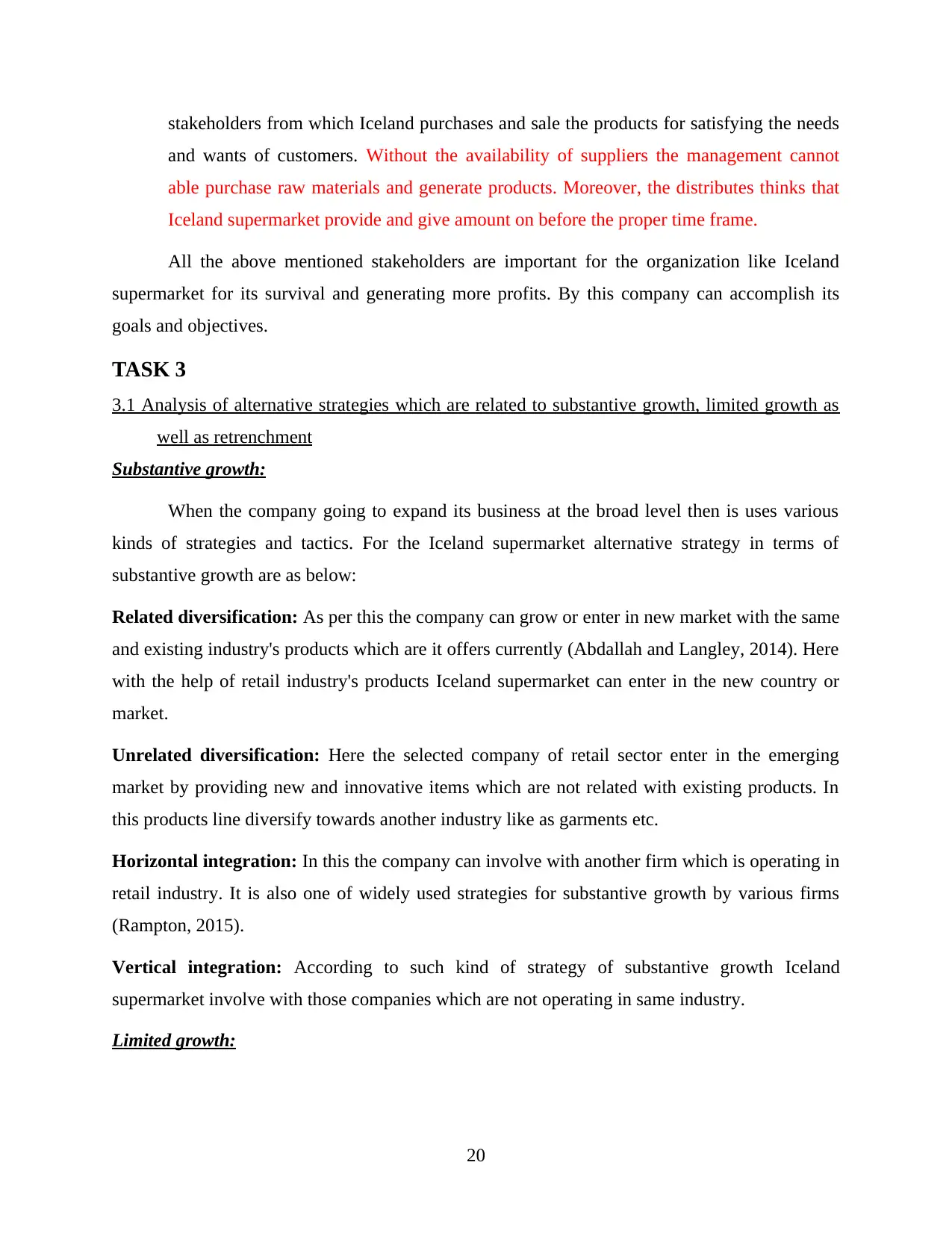
stakeholders from which Iceland purchases and sale the products for satisfying the needs
and wants of customers. Without the availability of suppliers the management cannot
able purchase raw materials and generate products. Moreover, the distributes thinks that
Iceland supermarket provide and give amount on before the proper time frame.
All the above mentioned stakeholders are important for the organization like Iceland
supermarket for its survival and generating more profits. By this company can accomplish its
goals and objectives.
TASK 3
3.1 Analysis of alternative strategies which are related to substantive growth, limited growth as
well as retrenchment
Substantive growth:
When the company going to expand its business at the broad level then is uses various
kinds of strategies and tactics. For the Iceland supermarket alternative strategy in terms of
substantive growth are as below:
Related diversification: As per this the company can grow or enter in new market with the same
and existing industry's products which are it offers currently (Abdallah and Langley, 2014). Here
with the help of retail industry's products Iceland supermarket can enter in the new country or
market.
Unrelated diversification: Here the selected company of retail sector enter in the emerging
market by providing new and innovative items which are not related with existing products. In
this products line diversify towards another industry like as garments etc.
Horizontal integration: In this the company can involve with another firm which is operating in
retail industry. It is also one of widely used strategies for substantive growth by various firms
(Rampton, 2015).
Vertical integration: According to such kind of strategy of substantive growth Iceland
supermarket involve with those companies which are not operating in same industry.
Limited growth:
20
and wants of customers. Without the availability of suppliers the management cannot
able purchase raw materials and generate products. Moreover, the distributes thinks that
Iceland supermarket provide and give amount on before the proper time frame.
All the above mentioned stakeholders are important for the organization like Iceland
supermarket for its survival and generating more profits. By this company can accomplish its
goals and objectives.
TASK 3
3.1 Analysis of alternative strategies which are related to substantive growth, limited growth as
well as retrenchment
Substantive growth:
When the company going to expand its business at the broad level then is uses various
kinds of strategies and tactics. For the Iceland supermarket alternative strategy in terms of
substantive growth are as below:
Related diversification: As per this the company can grow or enter in new market with the same
and existing industry's products which are it offers currently (Abdallah and Langley, 2014). Here
with the help of retail industry's products Iceland supermarket can enter in the new country or
market.
Unrelated diversification: Here the selected company of retail sector enter in the emerging
market by providing new and innovative items which are not related with existing products. In
this products line diversify towards another industry like as garments etc.
Horizontal integration: In this the company can involve with another firm which is operating in
retail industry. It is also one of widely used strategies for substantive growth by various firms
(Rampton, 2015).
Vertical integration: According to such kind of strategy of substantive growth Iceland
supermarket involve with those companies which are not operating in same industry.
Limited growth:
20
Secure Best Marks with AI Grader
Need help grading? Try our AI Grader for instant feedback on your assignments.
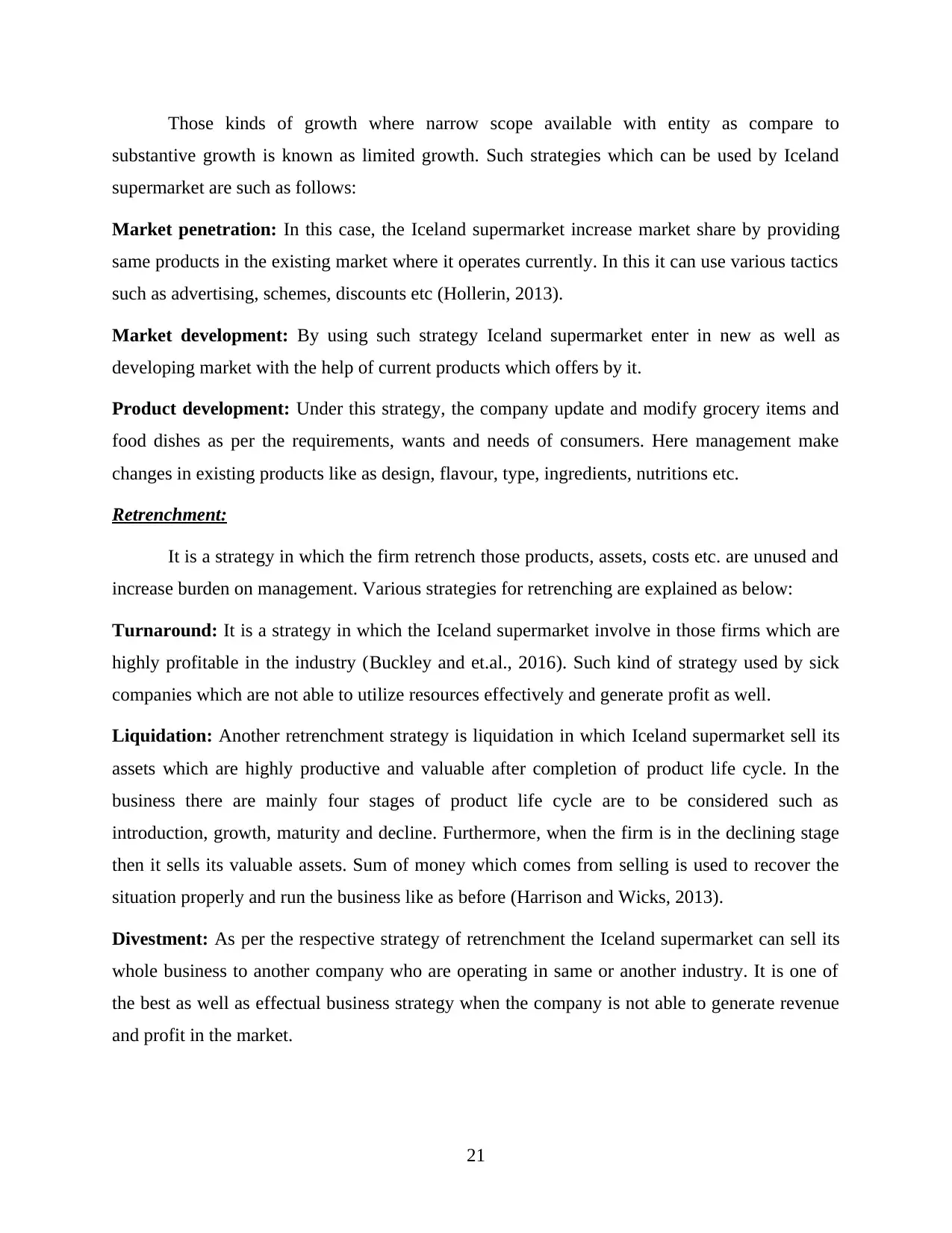
Those kinds of growth where narrow scope available with entity as compare to
substantive growth is known as limited growth. Such strategies which can be used by Iceland
supermarket are such as follows:
Market penetration: In this case, the Iceland supermarket increase market share by providing
same products in the existing market where it operates currently. In this it can use various tactics
such as advertising, schemes, discounts etc (Hollerin, 2013).
Market development: By using such strategy Iceland supermarket enter in new as well as
developing market with the help of current products which offers by it.
Product development: Under this strategy, the company update and modify grocery items and
food dishes as per the requirements, wants and needs of consumers. Here management make
changes in existing products like as design, flavour, type, ingredients, nutritions etc.
Retrenchment:
It is a strategy in which the firm retrench those products, assets, costs etc. are unused and
increase burden on management. Various strategies for retrenching are explained as below:
Turnaround: It is a strategy in which the Iceland supermarket involve in those firms which are
highly profitable in the industry (Buckley and et.al., 2016). Such kind of strategy used by sick
companies which are not able to utilize resources effectively and generate profit as well.
Liquidation: Another retrenchment strategy is liquidation in which Iceland supermarket sell its
assets which are highly productive and valuable after completion of product life cycle. In the
business there are mainly four stages of product life cycle are to be considered such as
introduction, growth, maturity and decline. Furthermore, when the firm is in the declining stage
then it sells its valuable assets. Sum of money which comes from selling is used to recover the
situation properly and run the business like as before (Harrison and Wicks, 2013).
Divestment: As per the respective strategy of retrenchment the Iceland supermarket can sell its
whole business to another company who are operating in same or another industry. It is one of
the best as well as effectual business strategy when the company is not able to generate revenue
and profit in the market.
21
substantive growth is known as limited growth. Such strategies which can be used by Iceland
supermarket are such as follows:
Market penetration: In this case, the Iceland supermarket increase market share by providing
same products in the existing market where it operates currently. In this it can use various tactics
such as advertising, schemes, discounts etc (Hollerin, 2013).
Market development: By using such strategy Iceland supermarket enter in new as well as
developing market with the help of current products which offers by it.
Product development: Under this strategy, the company update and modify grocery items and
food dishes as per the requirements, wants and needs of consumers. Here management make
changes in existing products like as design, flavour, type, ingredients, nutritions etc.
Retrenchment:
It is a strategy in which the firm retrench those products, assets, costs etc. are unused and
increase burden on management. Various strategies for retrenching are explained as below:
Turnaround: It is a strategy in which the Iceland supermarket involve in those firms which are
highly profitable in the industry (Buckley and et.al., 2016). Such kind of strategy used by sick
companies which are not able to utilize resources effectively and generate profit as well.
Liquidation: Another retrenchment strategy is liquidation in which Iceland supermarket sell its
assets which are highly productive and valuable after completion of product life cycle. In the
business there are mainly four stages of product life cycle are to be considered such as
introduction, growth, maturity and decline. Furthermore, when the firm is in the declining stage
then it sells its valuable assets. Sum of money which comes from selling is used to recover the
situation properly and run the business like as before (Harrison and Wicks, 2013).
Divestment: As per the respective strategy of retrenchment the Iceland supermarket can sell its
whole business to another company who are operating in same or another industry. It is one of
the best as well as effectual business strategy when the company is not able to generate revenue
and profit in the market.
21
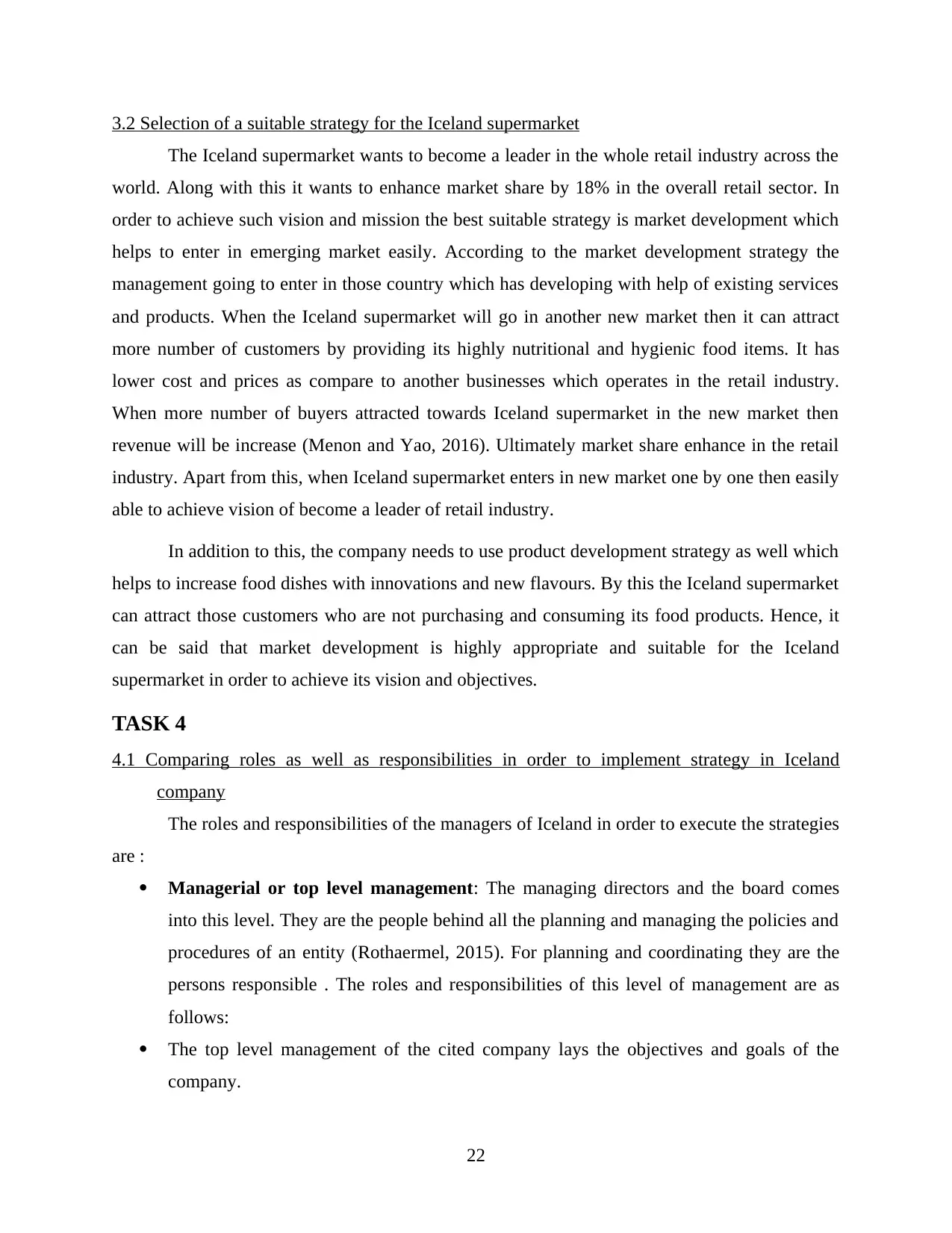
3.2 Selection of a suitable strategy for the Iceland supermarket
The Iceland supermarket wants to become a leader in the whole retail industry across the
world. Along with this it wants to enhance market share by 18% in the overall retail sector. In
order to achieve such vision and mission the best suitable strategy is market development which
helps to enter in emerging market easily. According to the market development strategy the
management going to enter in those country which has developing with help of existing services
and products. When the Iceland supermarket will go in another new market then it can attract
more number of customers by providing its highly nutritional and hygienic food items. It has
lower cost and prices as compare to another businesses which operates in the retail industry.
When more number of buyers attracted towards Iceland supermarket in the new market then
revenue will be increase (Menon and Yao, 2016). Ultimately market share enhance in the retail
industry. Apart from this, when Iceland supermarket enters in new market one by one then easily
able to achieve vision of become a leader of retail industry.
In addition to this, the company needs to use product development strategy as well which
helps to increase food dishes with innovations and new flavours. By this the Iceland supermarket
can attract those customers who are not purchasing and consuming its food products. Hence, it
can be said that market development is highly appropriate and suitable for the Iceland
supermarket in order to achieve its vision and objectives.
TASK 4
4.1 Comparing roles as well as responsibilities in order to implement strategy in Iceland
company
The roles and responsibilities of the managers of Iceland in order to execute the strategies
are :
Managerial or top level management: The managing directors and the board comes
into this level. They are the people behind all the planning and managing the policies and
procedures of an entity (Rothaermel, 2015). For planning and coordinating they are the
persons responsible . The roles and responsibilities of this level of management are as
follows:
The top level management of the cited company lays the objectives and goals of the
company.
22
The Iceland supermarket wants to become a leader in the whole retail industry across the
world. Along with this it wants to enhance market share by 18% in the overall retail sector. In
order to achieve such vision and mission the best suitable strategy is market development which
helps to enter in emerging market easily. According to the market development strategy the
management going to enter in those country which has developing with help of existing services
and products. When the Iceland supermarket will go in another new market then it can attract
more number of customers by providing its highly nutritional and hygienic food items. It has
lower cost and prices as compare to another businesses which operates in the retail industry.
When more number of buyers attracted towards Iceland supermarket in the new market then
revenue will be increase (Menon and Yao, 2016). Ultimately market share enhance in the retail
industry. Apart from this, when Iceland supermarket enters in new market one by one then easily
able to achieve vision of become a leader of retail industry.
In addition to this, the company needs to use product development strategy as well which
helps to increase food dishes with innovations and new flavours. By this the Iceland supermarket
can attract those customers who are not purchasing and consuming its food products. Hence, it
can be said that market development is highly appropriate and suitable for the Iceland
supermarket in order to achieve its vision and objectives.
TASK 4
4.1 Comparing roles as well as responsibilities in order to implement strategy in Iceland
company
The roles and responsibilities of the managers of Iceland in order to execute the strategies
are :
Managerial or top level management: The managing directors and the board comes
into this level. They are the people behind all the planning and managing the policies and
procedures of an entity (Rothaermel, 2015). For planning and coordinating they are the
persons responsible . The roles and responsibilities of this level of management are as
follows:
The top level management of the cited company lays the objectives and goals of the
company.
22
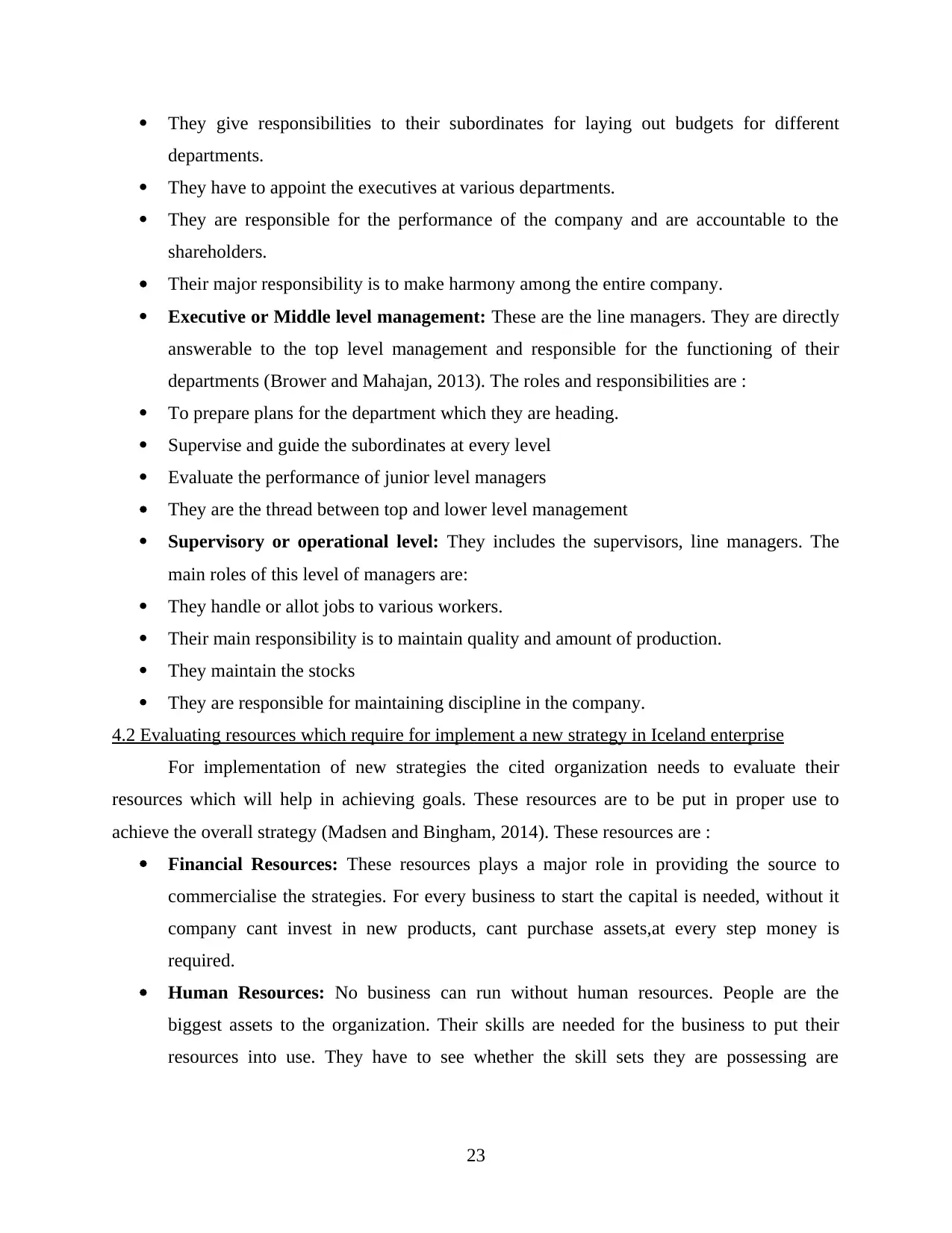
They give responsibilities to their subordinates for laying out budgets for different
departments.
They have to appoint the executives at various departments.
They are responsible for the performance of the company and are accountable to the
shareholders.
Their major responsibility is to make harmony among the entire company.
Executive or Middle level management: These are the line managers. They are directly
answerable to the top level management and responsible for the functioning of their
departments (Brower and Mahajan, 2013). The roles and responsibilities are :
To prepare plans for the department which they are heading.
Supervise and guide the subordinates at every level
Evaluate the performance of junior level managers
They are the thread between top and lower level management
Supervisory or operational level: They includes the supervisors, line managers. The
main roles of this level of managers are:
They handle or allot jobs to various workers.
Their main responsibility is to maintain quality and amount of production.
They maintain the stocks
They are responsible for maintaining discipline in the company.
4.2 Evaluating resources which require for implement a new strategy in Iceland enterprise
For implementation of new strategies the cited organization needs to evaluate their
resources which will help in achieving goals. These resources are to be put in proper use to
achieve the overall strategy (Madsen and Bingham, 2014). These resources are :
Financial Resources: These resources plays a major role in providing the source to
commercialise the strategies. For every business to start the capital is needed, without it
company cant invest in new products, cant purchase assets,at every step money is
required.
Human Resources: No business can run without human resources. People are the
biggest assets to the organization. Their skills are needed for the business to put their
resources into use. They have to see whether the skill sets they are possessing are
23
departments.
They have to appoint the executives at various departments.
They are responsible for the performance of the company and are accountable to the
shareholders.
Their major responsibility is to make harmony among the entire company.
Executive or Middle level management: These are the line managers. They are directly
answerable to the top level management and responsible for the functioning of their
departments (Brower and Mahajan, 2013). The roles and responsibilities are :
To prepare plans for the department which they are heading.
Supervise and guide the subordinates at every level
Evaluate the performance of junior level managers
They are the thread between top and lower level management
Supervisory or operational level: They includes the supervisors, line managers. The
main roles of this level of managers are:
They handle or allot jobs to various workers.
Their main responsibility is to maintain quality and amount of production.
They maintain the stocks
They are responsible for maintaining discipline in the company.
4.2 Evaluating resources which require for implement a new strategy in Iceland enterprise
For implementation of new strategies the cited organization needs to evaluate their
resources which will help in achieving goals. These resources are to be put in proper use to
achieve the overall strategy (Madsen and Bingham, 2014). These resources are :
Financial Resources: These resources plays a major role in providing the source to
commercialise the strategies. For every business to start the capital is needed, without it
company cant invest in new products, cant purchase assets,at every step money is
required.
Human Resources: No business can run without human resources. People are the
biggest assets to the organization. Their skills are needed for the business to put their
resources into use. They have to see whether the skill sets they are possessing are
23
Paraphrase This Document
Need a fresh take? Get an instant paraphrase of this document with our AI Paraphraser
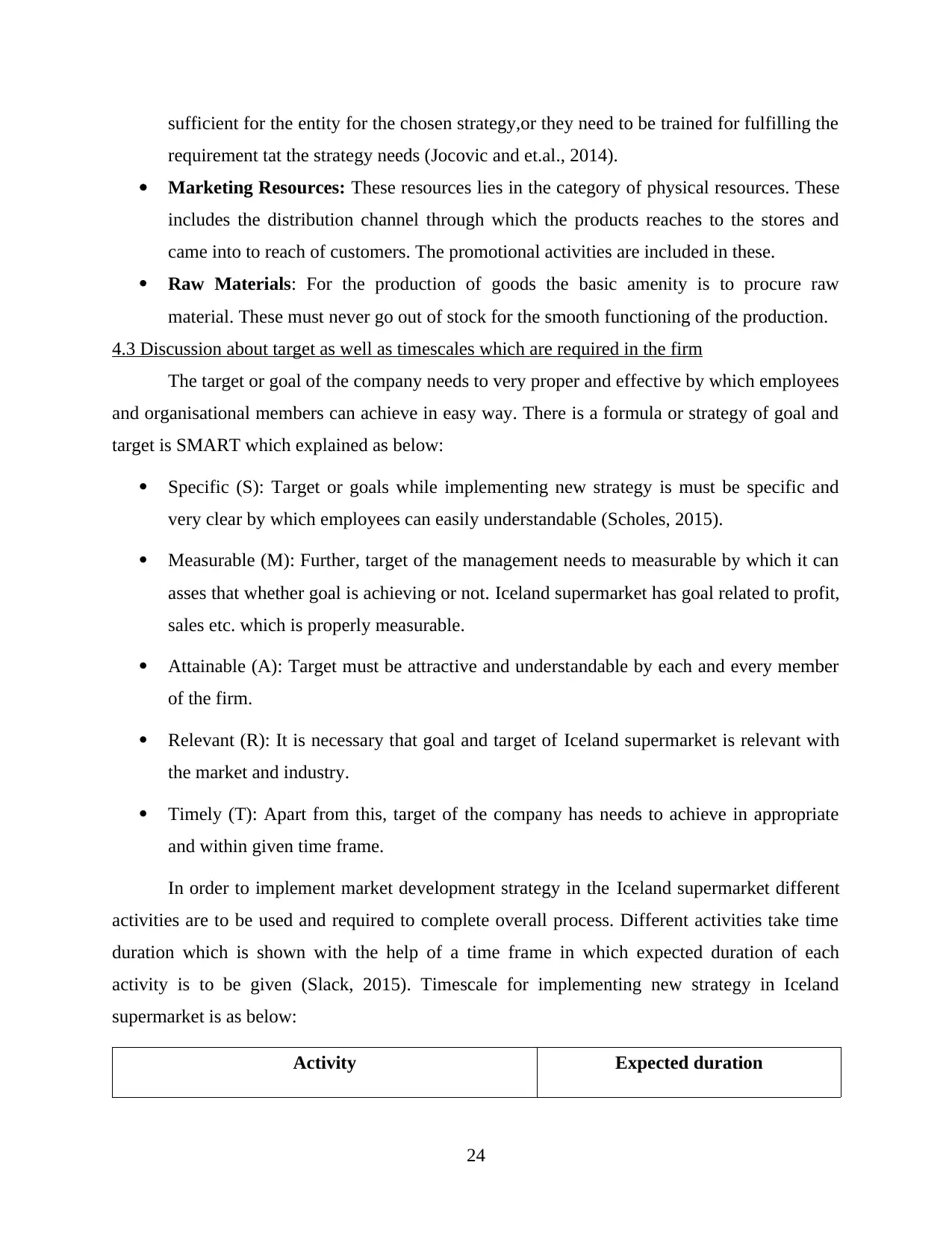
sufficient for the entity for the chosen strategy,or they need to be trained for fulfilling the
requirement tat the strategy needs (Jocovic and et.al., 2014).
Marketing Resources: These resources lies in the category of physical resources. These
includes the distribution channel through which the products reaches to the stores and
came into to reach of customers. The promotional activities are included in these.
Raw Materials: For the production of goods the basic amenity is to procure raw
material. These must never go out of stock for the smooth functioning of the production.
4.3 Discussion about target as well as timescales which are required in the firm
The target or goal of the company needs to very proper and effective by which employees
and organisational members can achieve in easy way. There is a formula or strategy of goal and
target is SMART which explained as below:
Specific (S): Target or goals while implementing new strategy is must be specific and
very clear by which employees can easily understandable (Scholes, 2015).
Measurable (M): Further, target of the management needs to measurable by which it can
asses that whether goal is achieving or not. Iceland supermarket has goal related to profit,
sales etc. which is properly measurable.
Attainable (A): Target must be attractive and understandable by each and every member
of the firm.
Relevant (R): It is necessary that goal and target of Iceland supermarket is relevant with
the market and industry.
Timely (T): Apart from this, target of the company has needs to achieve in appropriate
and within given time frame.
In order to implement market development strategy in the Iceland supermarket different
activities are to be used and required to complete overall process. Different activities take time
duration which is shown with the help of a time frame in which expected duration of each
activity is to be given (Slack, 2015). Timescale for implementing new strategy in Iceland
supermarket is as below:
Activity Expected duration
24
requirement tat the strategy needs (Jocovic and et.al., 2014).
Marketing Resources: These resources lies in the category of physical resources. These
includes the distribution channel through which the products reaches to the stores and
came into to reach of customers. The promotional activities are included in these.
Raw Materials: For the production of goods the basic amenity is to procure raw
material. These must never go out of stock for the smooth functioning of the production.
4.3 Discussion about target as well as timescales which are required in the firm
The target or goal of the company needs to very proper and effective by which employees
and organisational members can achieve in easy way. There is a formula or strategy of goal and
target is SMART which explained as below:
Specific (S): Target or goals while implementing new strategy is must be specific and
very clear by which employees can easily understandable (Scholes, 2015).
Measurable (M): Further, target of the management needs to measurable by which it can
asses that whether goal is achieving or not. Iceland supermarket has goal related to profit,
sales etc. which is properly measurable.
Attainable (A): Target must be attractive and understandable by each and every member
of the firm.
Relevant (R): It is necessary that goal and target of Iceland supermarket is relevant with
the market and industry.
Timely (T): Apart from this, target of the company has needs to achieve in appropriate
and within given time frame.
In order to implement market development strategy in the Iceland supermarket different
activities are to be used and required to complete overall process. Different activities take time
duration which is shown with the help of a time frame in which expected duration of each
activity is to be given (Slack, 2015). Timescale for implementing new strategy in Iceland
supermarket is as below:
Activity Expected duration
24
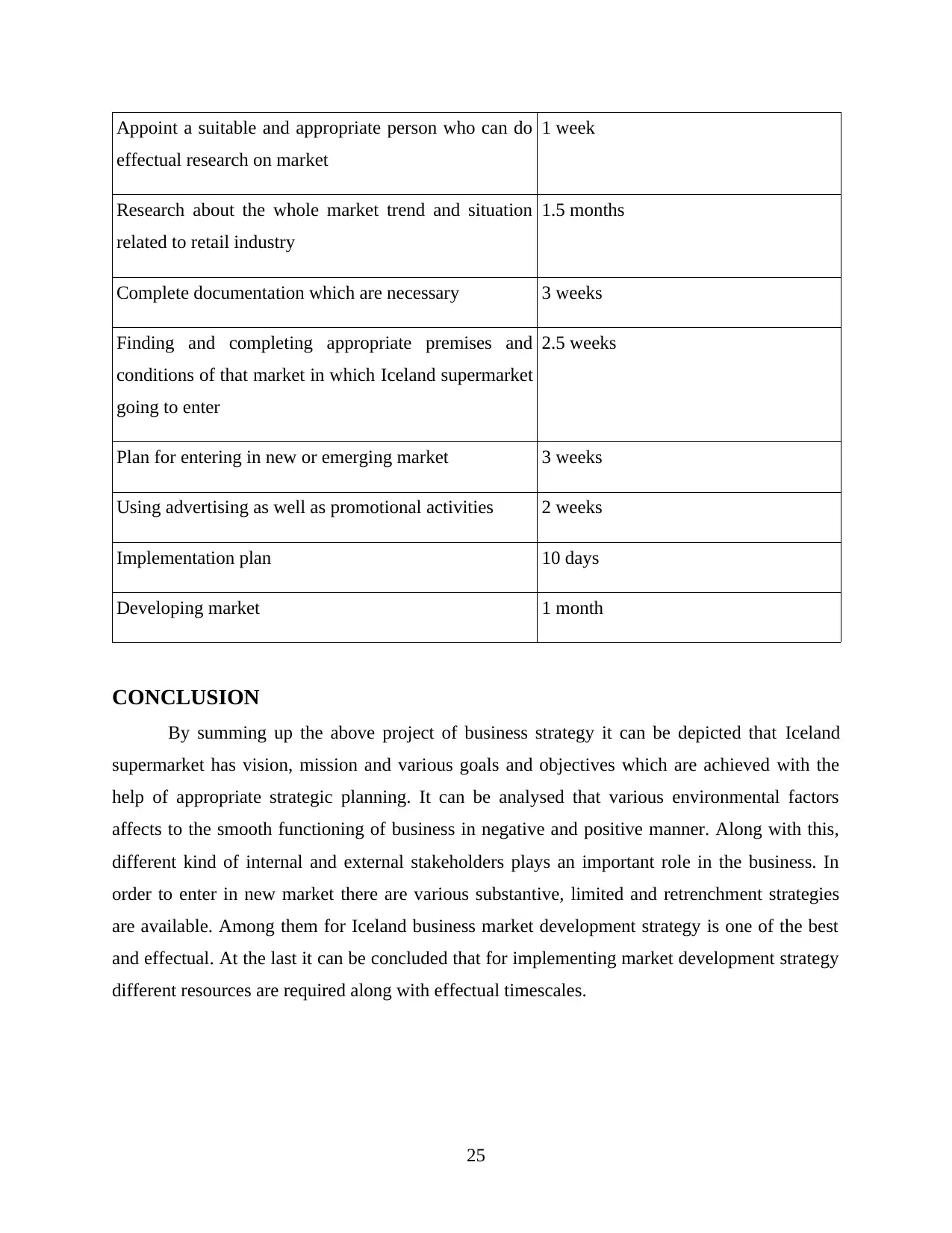
Appoint a suitable and appropriate person who can do
effectual research on market
1 week
Research about the whole market trend and situation
related to retail industry
1.5 months
Complete documentation which are necessary 3 weeks
Finding and completing appropriate premises and
conditions of that market in which Iceland supermarket
going to enter
2.5 weeks
Plan for entering in new or emerging market 3 weeks
Using advertising as well as promotional activities 2 weeks
Implementation plan 10 days
Developing market 1 month
CONCLUSION
By summing up the above project of business strategy it can be depicted that Iceland
supermarket has vision, mission and various goals and objectives which are achieved with the
help of appropriate strategic planning. It can be analysed that various environmental factors
affects to the smooth functioning of business in negative and positive manner. Along with this,
different kind of internal and external stakeholders plays an important role in the business. In
order to enter in new market there are various substantive, limited and retrenchment strategies
are available. Among them for Iceland business market development strategy is one of the best
and effectual. At the last it can be concluded that for implementing market development strategy
different resources are required along with effectual timescales.
25
effectual research on market
1 week
Research about the whole market trend and situation
related to retail industry
1.5 months
Complete documentation which are necessary 3 weeks
Finding and completing appropriate premises and
conditions of that market in which Iceland supermarket
going to enter
2.5 weeks
Plan for entering in new or emerging market 3 weeks
Using advertising as well as promotional activities 2 weeks
Implementation plan 10 days
Developing market 1 month
CONCLUSION
By summing up the above project of business strategy it can be depicted that Iceland
supermarket has vision, mission and various goals and objectives which are achieved with the
help of appropriate strategic planning. It can be analysed that various environmental factors
affects to the smooth functioning of business in negative and positive manner. Along with this,
different kind of internal and external stakeholders plays an important role in the business. In
order to enter in new market there are various substantive, limited and retrenchment strategies
are available. Among them for Iceland business market development strategy is one of the best
and effectual. At the last it can be concluded that for implementing market development strategy
different resources are required along with effectual timescales.
25
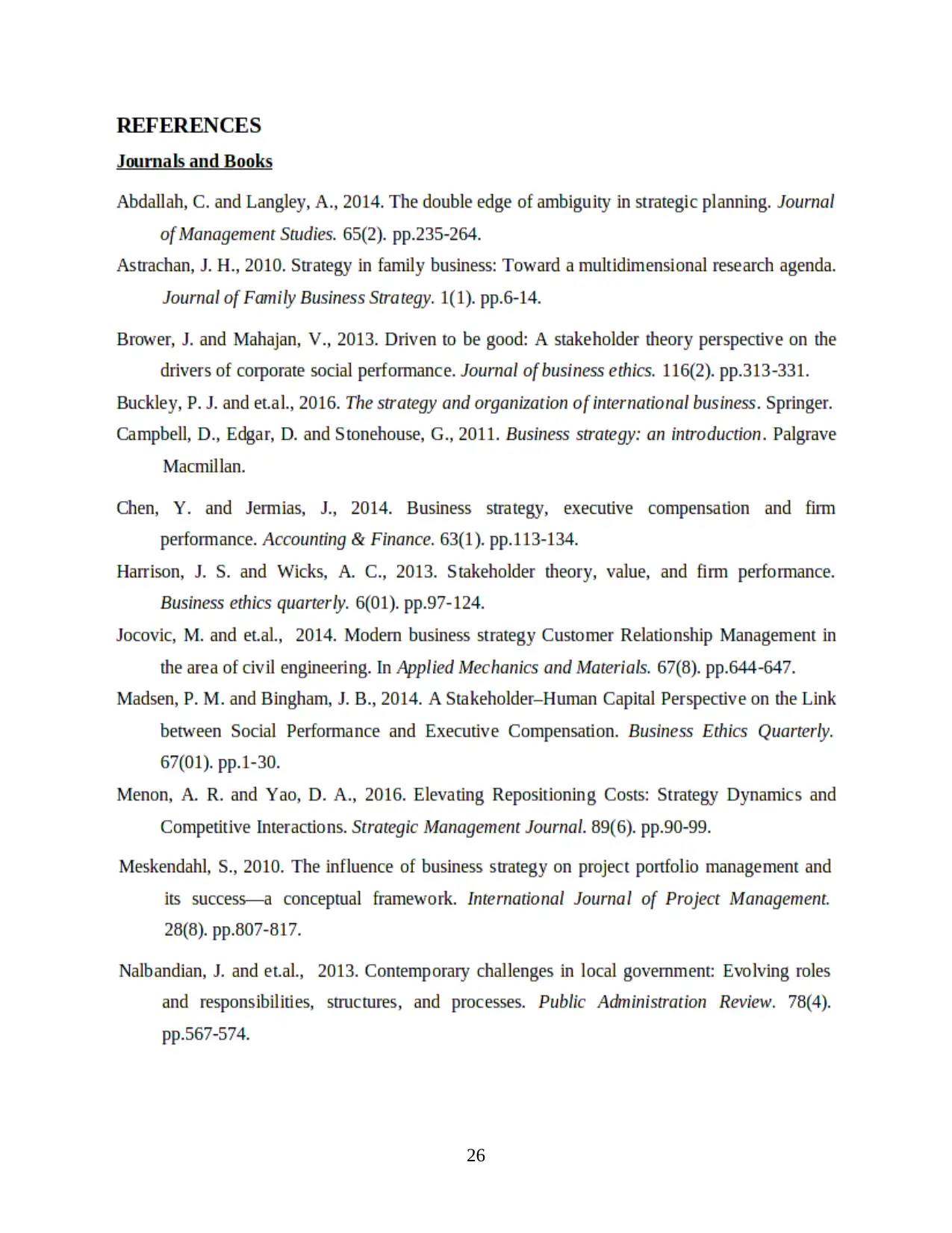
26
Secure Best Marks with AI Grader
Need help grading? Try our AI Grader for instant feedback on your assignments.
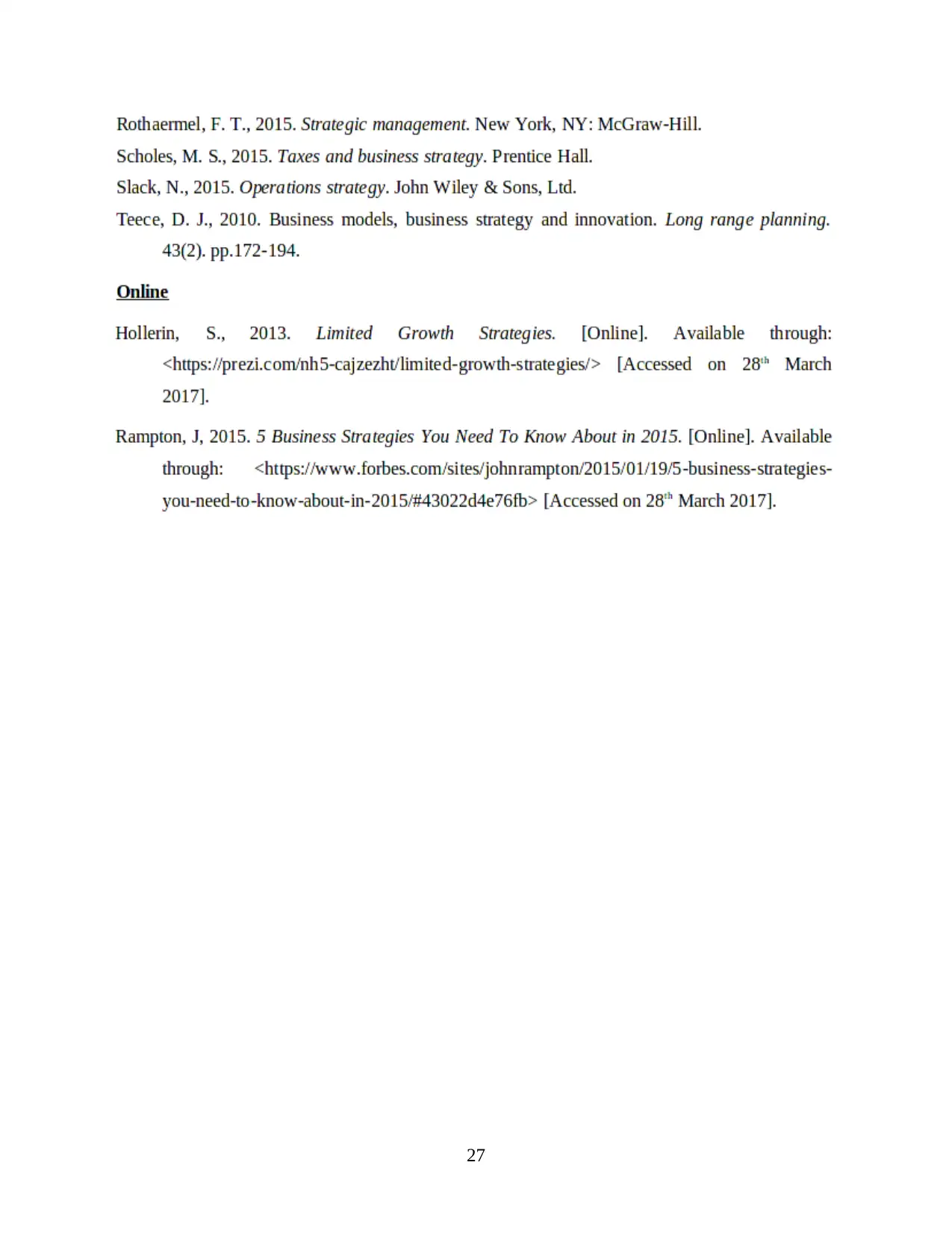
27
1 out of 29
Related Documents
Your All-in-One AI-Powered Toolkit for Academic Success.
+13062052269
info@desklib.com
Available 24*7 on WhatsApp / Email
![[object Object]](/_next/static/media/star-bottom.7253800d.svg)
Unlock your academic potential
© 2024 | Zucol Services PVT LTD | All rights reserved.





